Physical Address
304 North Cardinal St.
Dorchester Center, MA 02124
The authors acknowledge and thank Children’s Hospital of Pittsburgh, Department of Radiology, and University of Pittsburgh School of Medicine, Department of Neuroradiology, for providing many of the radiographs and CT scans in this chapter.
Supplemental videos are available at expertconsult.com .
The importance of pediatricians and family physicians having understanding of and experience with otolaryngologic problems and being skilled in techniques of examination of the head and neck region cannot be overemphasized. One study revealed that more than one-third of all visits to pediatricians’ offices were prompted by ear symptoms. When nasal and oral symptoms are included, ear, nose, and throat pathology accounts for more than 50% of all visits. With patience and proper equipment, pediatricians can complete a thorough examination on almost all children. If a disorder fails to respond to therapy or becomes chronic or recurrent, or if an unusual problem is encountered, a pediatric otolaryngology consultation should be sought.
Successful examination of the ears, nose, and oropharynx of a young child can present some challenges, especially with older infants and toddlers. This can be a particular problem in children who have had previous bad experiences. An examiner’s patience, warmth, humor, and careful explanation help reduce fear and enhance cooperation.
Whenever possible, the child should be allowed to sit on the parent’s lap. Pacifiers, puppets and other toys, and tongue blades with faces drawn on them can all serve to reduce anxiety, enlist the child’s trust, and distract attention. Gradual introduction of the equipment can also be helpful, especially if done in a playful way. The child can be asked to blow out the otoscope light while the examiner turns it off, urged to catch the light spot as the examiner moves it around, and even allowed to look in the parent’s or examiner’s ears ( Fig. 24.1 ). Parents can also help demonstrate maneuvers for opening the mouth, panting to depress the tongue, and holding the head back. Although this may take a little additional time at the outset, it often saves considerable time in the long run and makes future follow-up examinations far easier.
Ear pain (otalgia), discharge from the ear (otorrhea), and suspected hearing loss are three of the more common and specific otic symptoms for which parents seek medical attention for their children. Less specific symptoms such as pulling or tugging at the ears, fussiness, and fever are also frequently encountered, particularly in children younger than 2 years old.
History should center on the nature and duration of symptoms, character of the clinical course, and possible antecedent treatment. Because many infections of the ear are recurrent and/or chronic, the parent should be asked about previous medical or surgical therapy (e.g., antibiotics, myringotomy, and/or tube insertion).
A brief review of the anatomy of the ear is helpful in developing a logical approach to any clinical abnormalities that may be encountered. The ear is conveniently divided into the following three regions ( Fig. 24.2 ):
The external ear includes the pinna, or auricle, and the external auditory canal, up to and including the tympanic membrane.
The middle ear is made up of the middle ear space, the inner surface of the eardrum, the ossicles, and the mastoid.
The inner ear comprises the cochlea (hearing), the labyrinth and semicircular canals (balance), and the main nerve trunks of the seventh and eighth cranial nerves.
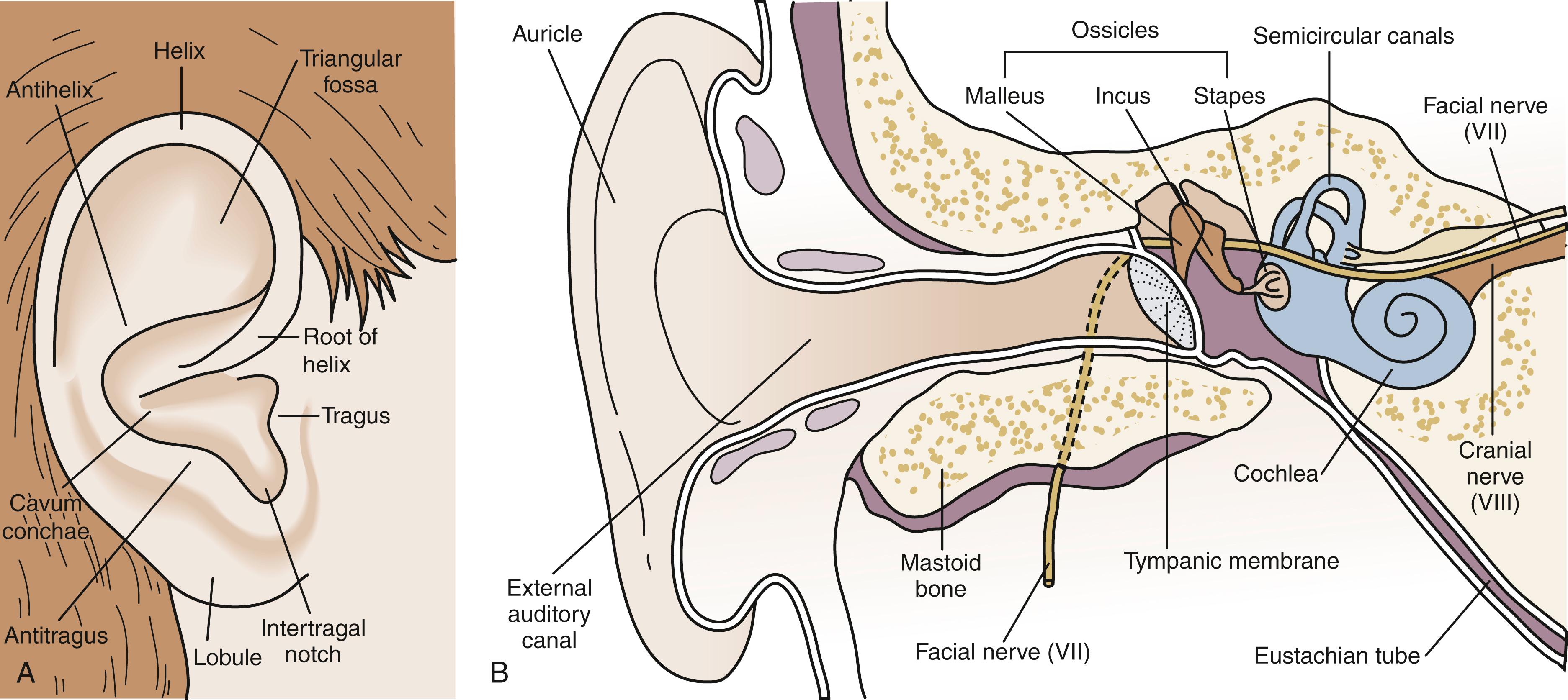
The examination should include inspection of the auricle, periauricular tissues, and external auditory canal and the entire tympanic membrane, including assessment of its mobility in response to positive and negative pressure with pneumatic otoscopy. This necessitates clearing the canal of cerumen or discharge by using a curette, cotton wick, lavage, or suction, and presumes that the tympanic membrane is intact ( Fig. 24.3A and B ). Use of a surgical otoscope head or an examining microscope assists visualization during the cleaning process. These procedures should be performed carefully and gently and attempted only after the child has been carefully immobilized to avoid trauma ( Fig. 24.4 ). It is extraordinarily easy to injure the canal during the process of cleaning the external ear. Hence great care must be taken; otherwise bleeding from the ensuing trauma obscures the examination and upsets the patient and parent. Steadying of the examiner’s hands on the child’s head while using the otoscope and instruments is an essential skill to avoid ear trauma. Both the patient and parent should be given a clear explanation of the procedure beforehand. Allowing older children to handle and look through the equipment before cleaning the ear reduces anxiety and enhances cooperation (see Fig. 24.3C ).
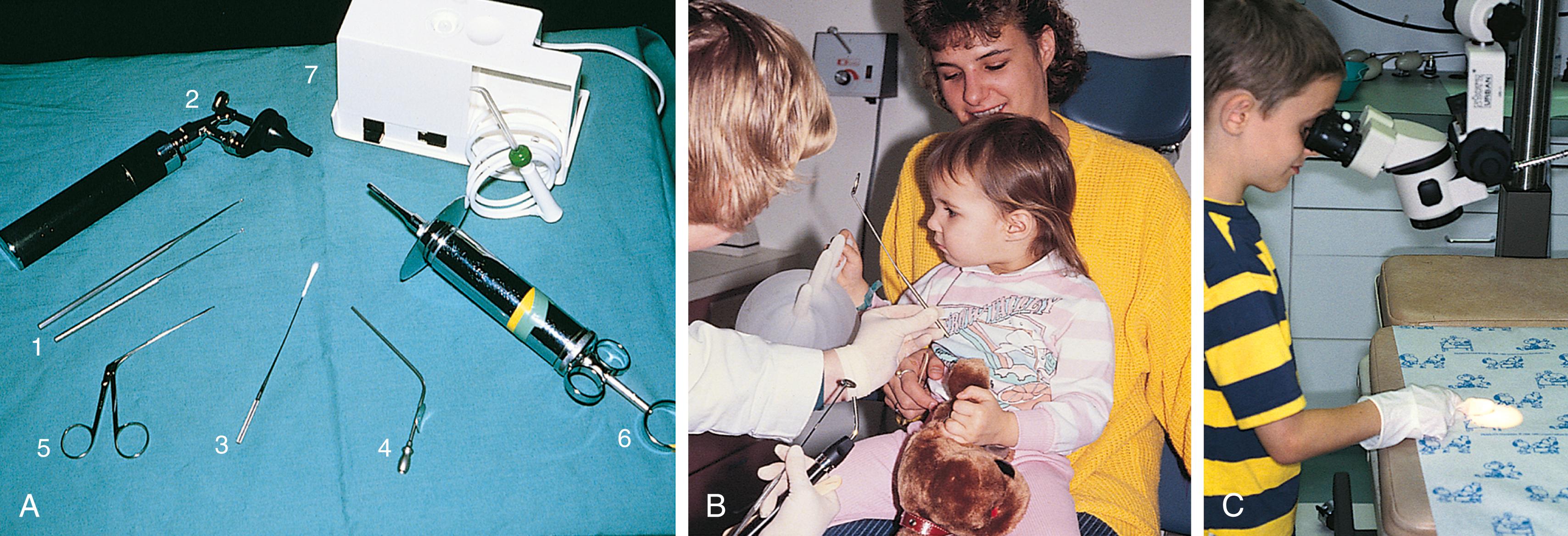
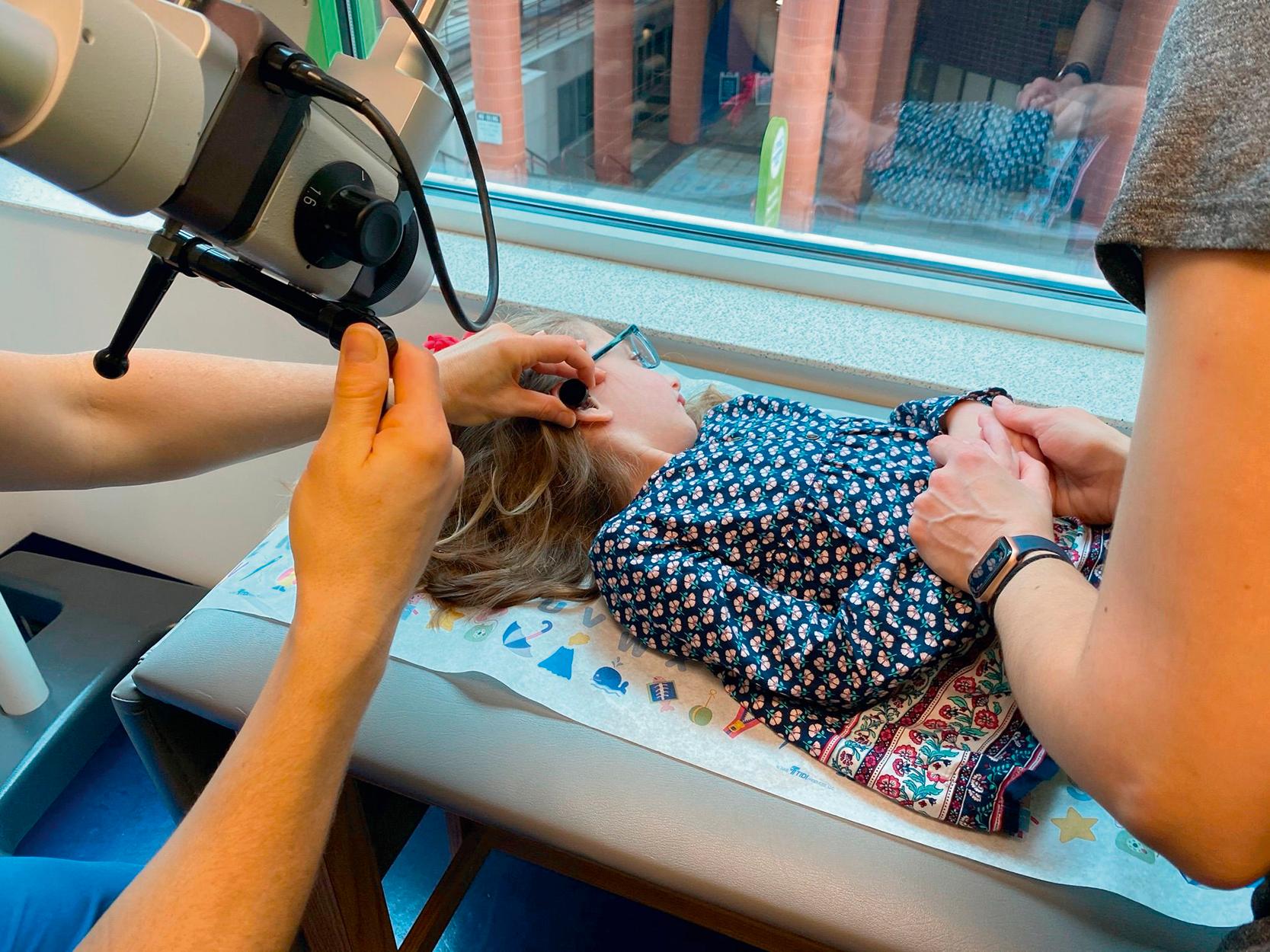
Because the external auditory canal is often angled in infants and young children, gentle lateral traction on the pinna is frequently necessary to assist visualization of the eardrum itself ( Fig. 24.5 ). In infants, the tympanic membrane tends to be oriented at a greater angle ( Fig. 24.6 ); the landmarks are less prominent; and the skin that lines the canal, being loosely attached, moves readily on insufflation of air, simulating a normally mobile eardrum. To avoid confusion, the canal should be inspected as the speculum is inserted to ensure that the transition between the canal wall and the tympanic membrane is visualized.
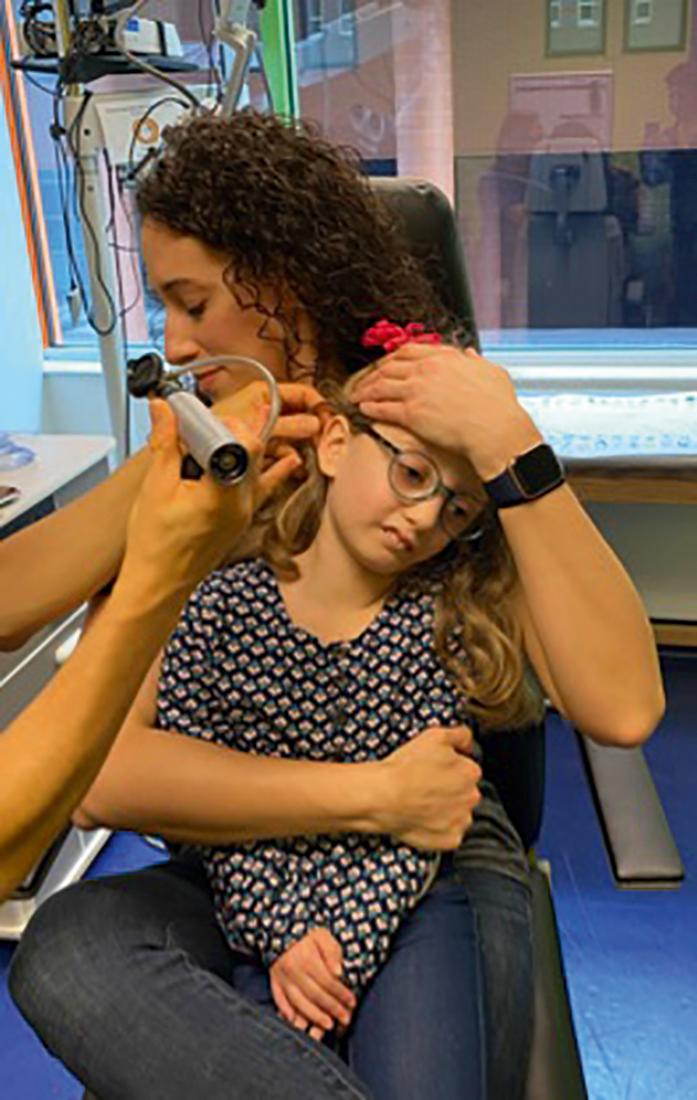
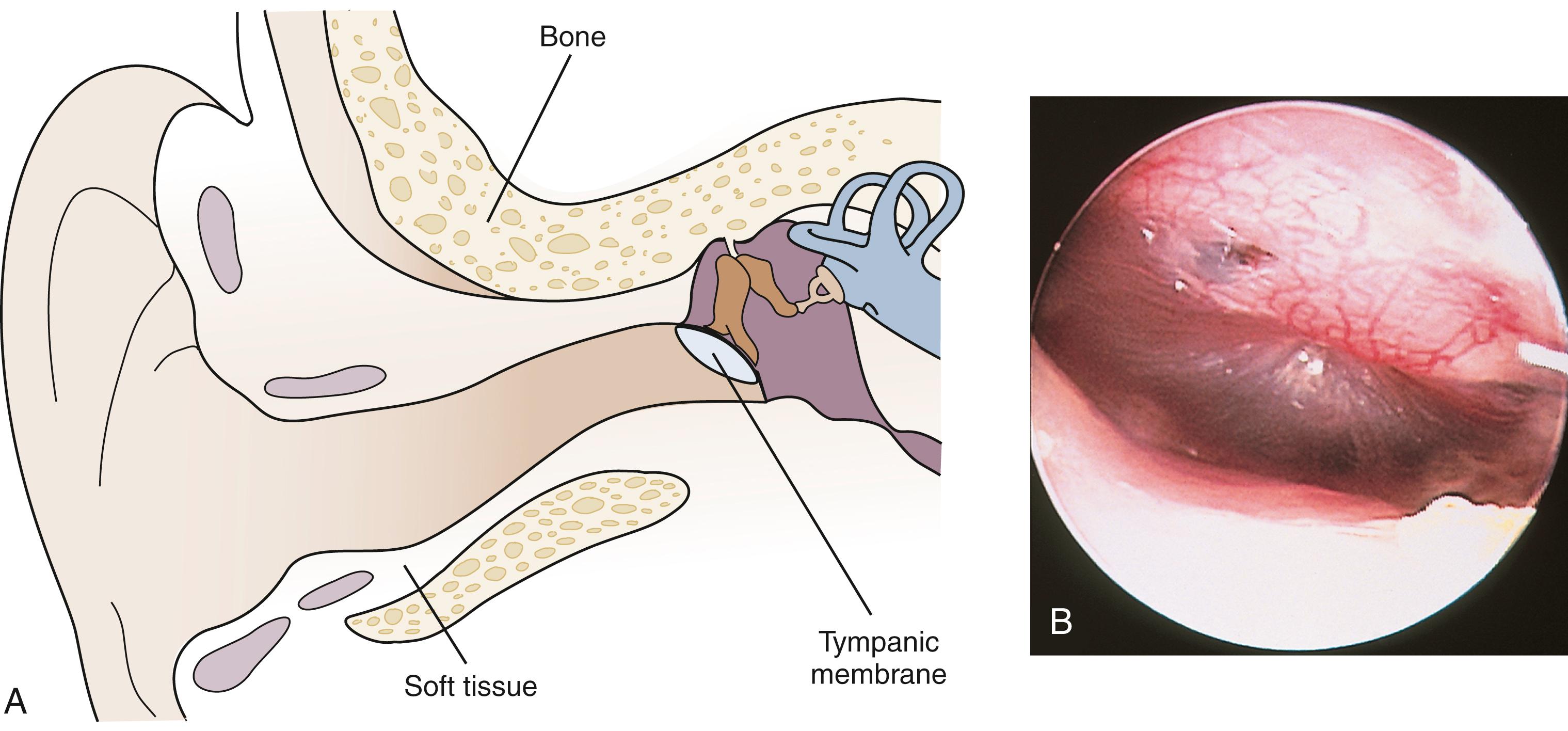
The pneumatic otoscope is the most valuable diagnostic tool when signs or symptoms of otitis media are present. Pediatricians, family practitioners, advanced practice providers, and otolaryngologists who treat children should be skilled in its use. Practical advice on the use of this instrument is as follows:
Use adequate light. A bright halogen lamp is better than an ordinary light bulb. Replace bulbs routinely every 4 to 6 months and provide for routine battery charging.
Choose a speculum of sufficient diameter and length to allow adequate penetration (10 to 15 mm) into the external canal for good eardrum visualization and a good seal for pneumatic otoscopy.
Restrain the patient (on the parent’s lap or on the examining table).
Brace the hand holding the otoscope on the child’s head to avoid ear canal trauma.
When otoscopic findings are unclear or when it is difficult to obtain a good air seal for pneumatic otoscopy, tympanometry can be highly useful in evaluating patients older than 8 months old ( Fig. 24.7 ). The procedure is of lesser value in young infants because the abundance of loose connective tissue lining the ear canal and the laxity of the cartilage at the entrance increase canal wall compliance and produce unreliable results.
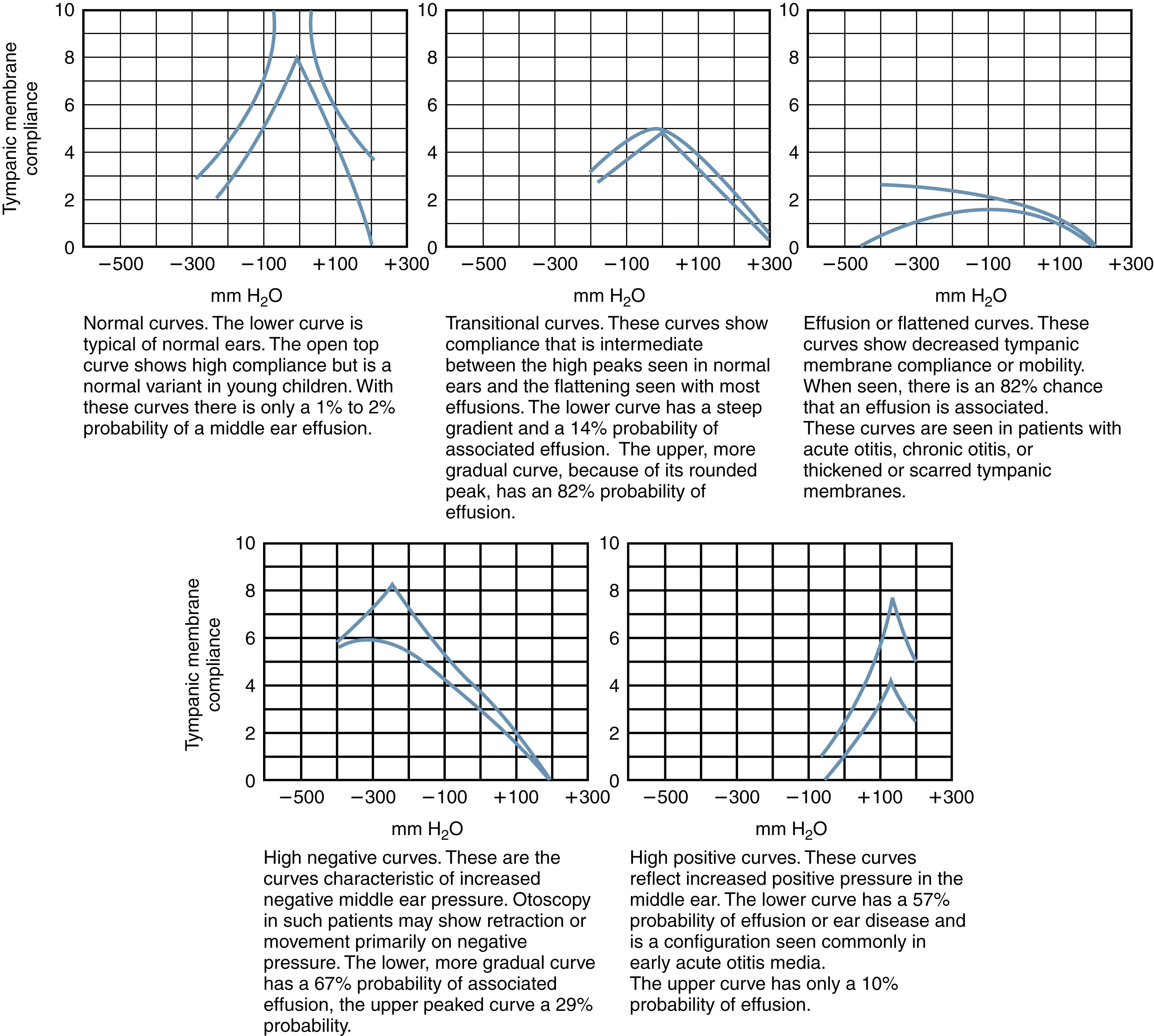
Because otitis media can be a reflection of both immunologic and anatomic abnormalities, the practitioner should be suspicious of possible underlying immune or temporal bone defects when seeing patients with chronic or frequently recurrent otitis media. The temporal bone is the bony housing for the auditory and vestibular systems. In addition, it provides bony protection for the facial nerve as it crosses from the brainstem to the facial muscles. The growth and development of this bone are affected in syndromes (e.g., Treacher Collins) that are characterized by altered midface growth ( Fig. 24.8 ). The soft tissues attached to the temporal bone, such as the muscles controlling eustachian tube function, can be abnormal in children with cleft palates (see the Palatal Disorders section, later). As a result, children with these disorders tend to have an increased incidence of otitis media.
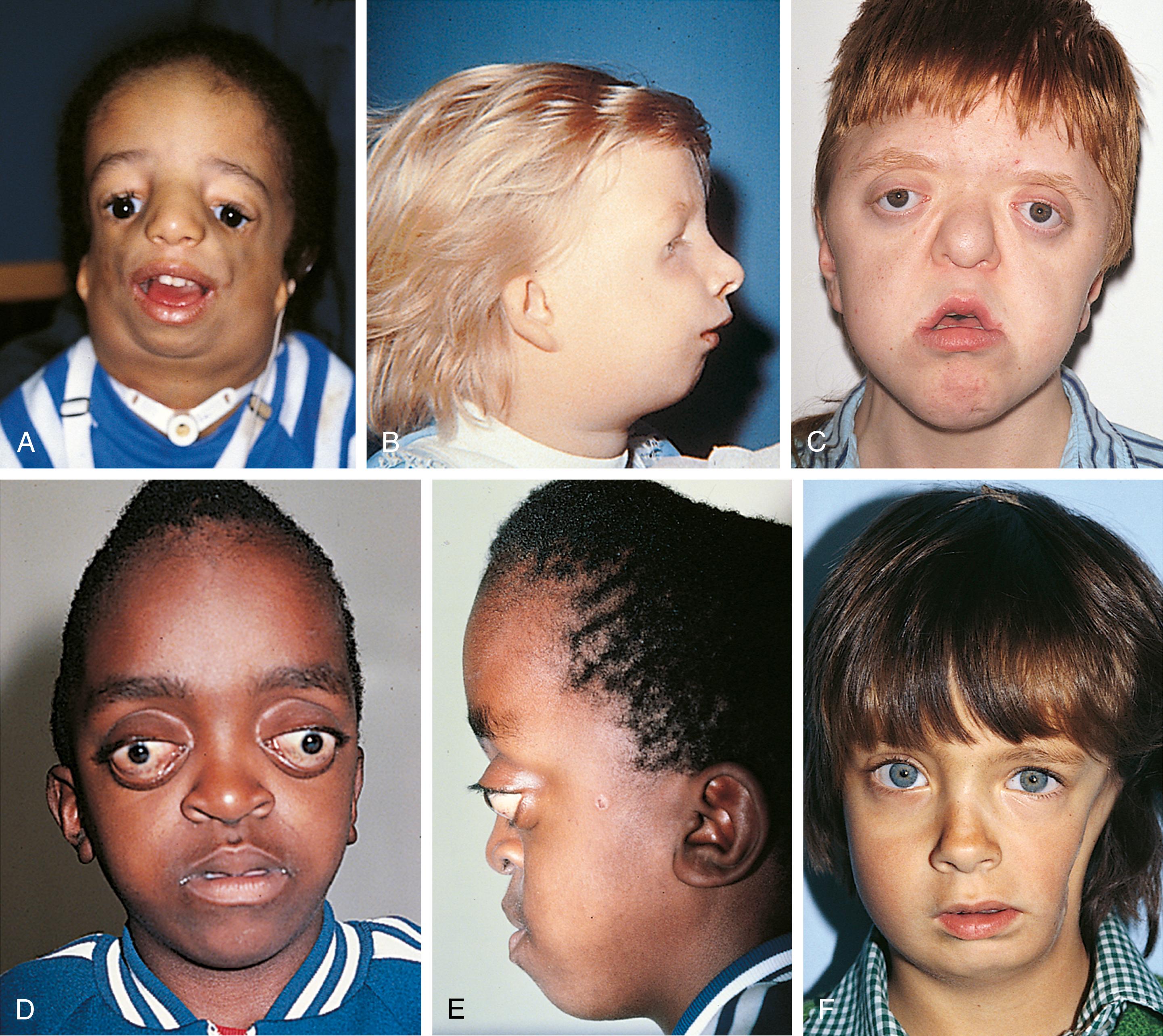
Children with chronic effusions who complain of or have parental concern for hearing loss, those with speech delays, or those with suspected congenital malformations must have their hearing evaluated by audiometry, evoked otoacoustic emissions, or brainstem evoked potentials. Patients with vertigo and/or problems of balance and those with facial weakness or asymmetry also warrant testing of hearing, facial nerve, and vestibular function. These children, and those suffering from malformations, may require computed tomography (CT), magnetic resonance imaging (MRI), or genetic studies in select cases to clarify the nature of the problem.
Examination of each child’s ear begins with inspection of the auricle and periauricular tissues for four important signs—discharge, displacement, discoloration, and deformity (the “four Ds”). The canal is normally smooth and angulated slightly in an anterior direction. Cerumen is often present; it varies in color from yellowish-white to tan to dark brown. It is secreted from glands interspersed among the hair follicles at the entrance to the ear canal and has some bacteriostatic activity. When cerumen obstructs the view, it must be removed to allow adequate visualization of the canal and tympanic membrane. When soft and moist, cerumen is easily removed with a curette. Removal may be more difficult if the cerumen is dry and flaky and may require removal with otologic forceps or, at times, instillation of drops. In some children, cerumen solidifies or has been packed in with cotton-tipped applicators, forming a firm plug that impedes sound conduction and requires softening for removal. Irrigation is contraindicated if there is any possibility that the eardrum may not be intact.
Ear discharge is a common complaint with a number of possible causes. When there is thick, white discharge and erythema of the canal wall, the physician should gently pull on the pinna. If this maneuver elicits pain and the canal wall is edematous, primary otitis externa is the likely diagnosis ( Fig. 24.9 ), although prolonged drainage from untreated otitis media with perforation may present a similar picture (see the Disorders of the Middle Ear section later). When the middle ear is the source of otic discharge, the tympanic membrane should show evidence of perforation (see Fig. 24.26 ). The major predisposing condition to primary otitis externa is prolonged excessive moisture in the ear canal, which promotes bacterial or fungal overgrowth. Thus, this is a common problem among swimmers. Another major source is the presence of a foreign body in the ear canal (see Fig. 24.19 ), which stimulates an intense inflammatory response and production of a foul-smelling purulent discharge. Thus, when otic drainage is encountered, the discharge must be gently removed under appropriate magnification to assess the condition of the tympanic membrane and to rule out the presence of perforation and foreign objects. This can be accomplished either by gentle wiping with cotton wicks or by careful suctioning (see Fig. 24.3 ).
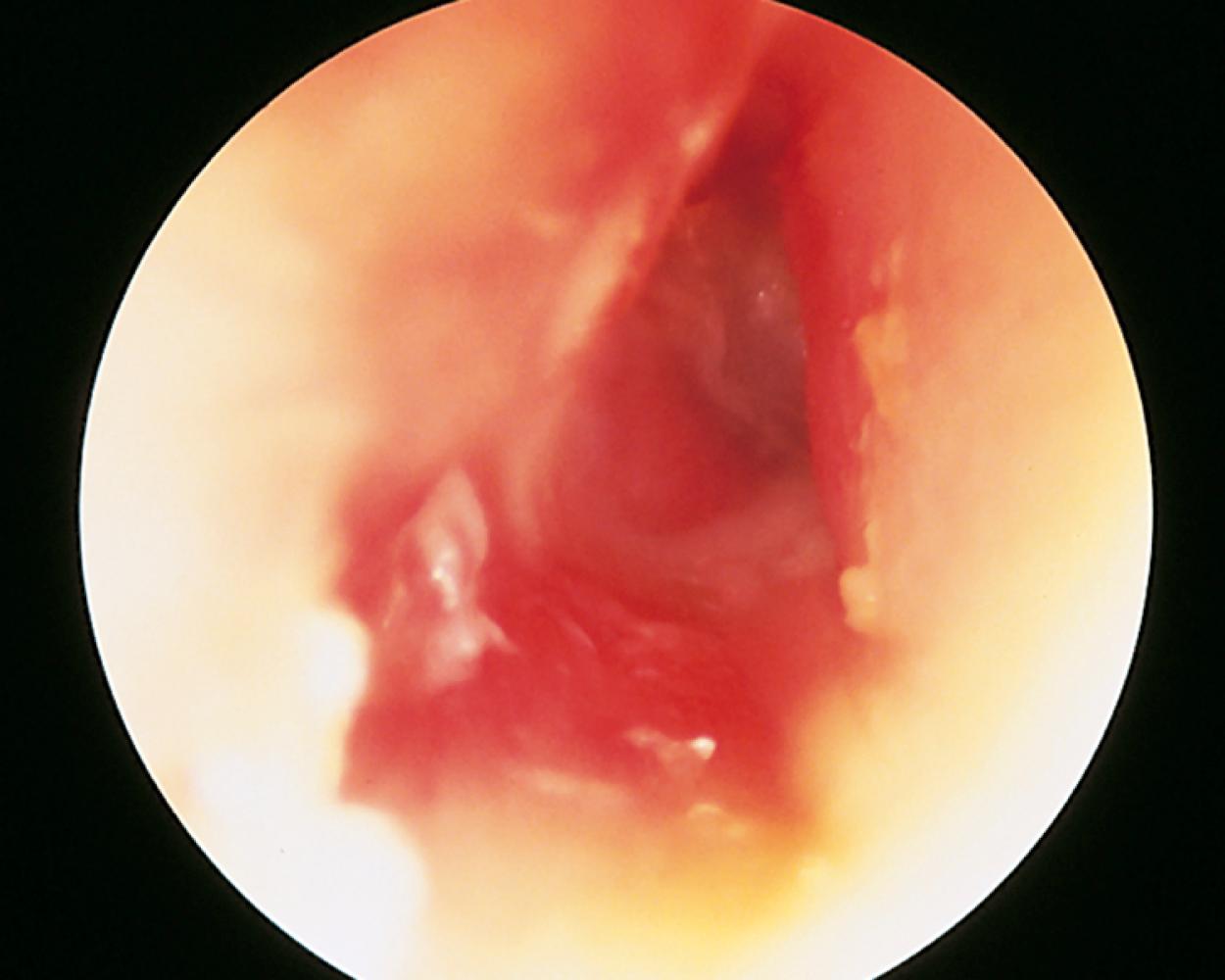
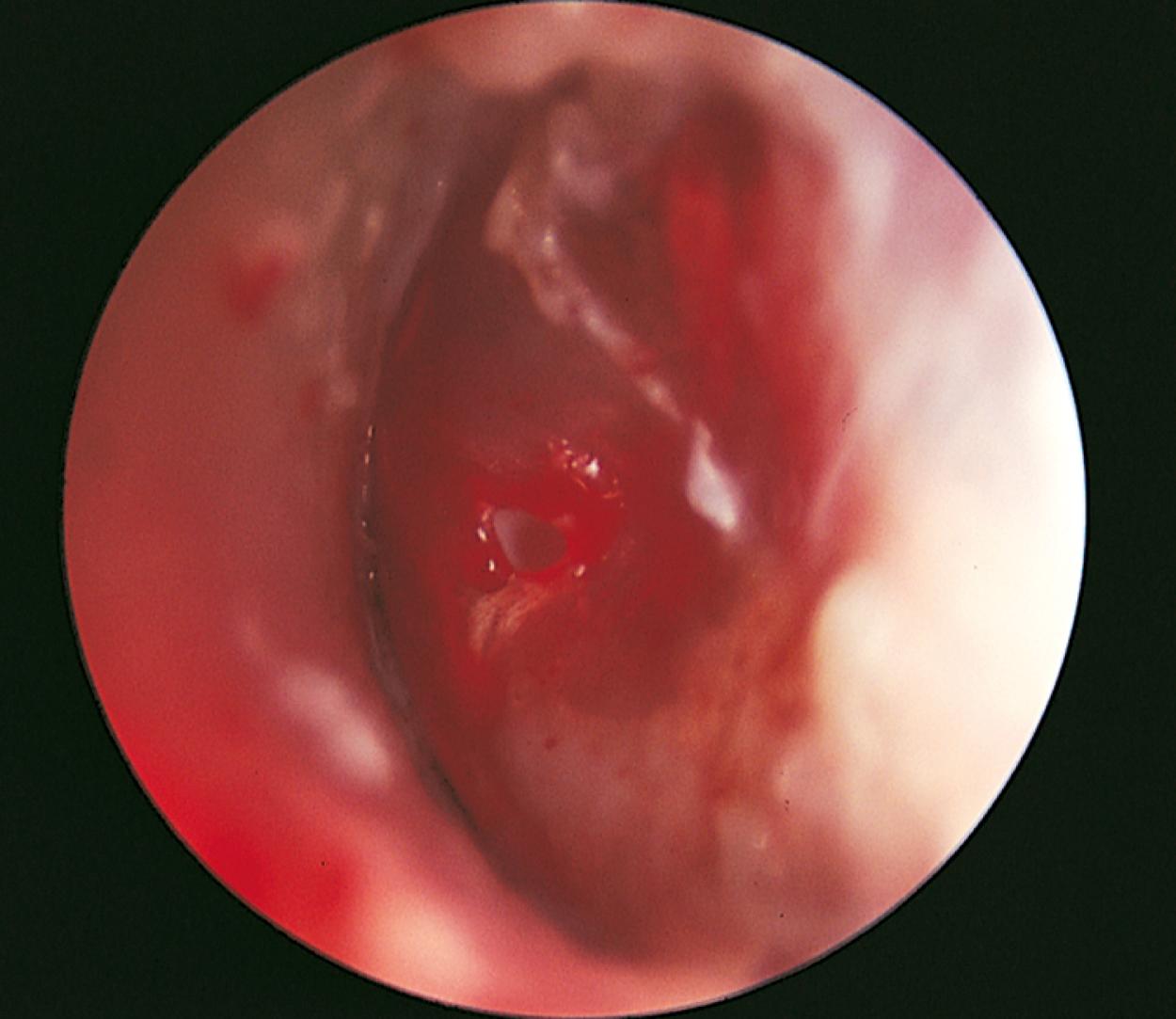

If the history indicates that the drainage is persistent or recurrent despite therapy, a culture should be obtained to determine both the causative organism and its sensitivity to antimicrobial agents. Treatment consists primarily of topical otic antimicrobial/steroid preparations. Systemic antibiotics should be given when pain is severe; when there is evidence of otitis media; or when, despite attempts at cleaning, there is still uncertainty about an infection of the middle ear. Parenteral antibiotics may be required when the process has extended, producing cellulitis of the periauricular soft tissues or frank mastoiditis.
Displacement of the pinna away from the skull is a worrisome sign. The most severe condition causing displacement is mastoiditis, resulting from extension of a middle ear infection through the mastoid air cells and out to the periosteum of the skull. In addition to displacement, important clinical signs of mastoiditis include erythema and edema and possibly fluctuance of the skin overlying the mastoid, exquisite tenderness on palpation of the mastoid process, a sagging ear canal, purulent otorrhea, fever, and usually toxicity ( Fig. 24.10 ). This condition is now less common and is seen mainly in patients with long-standing, untreated, or inadequately treated otitis media. Recognition, prompt institution of parenteral antibiotic therapy, and myringotomy with culture and sensitivity testing of middle and inner ear effusion are crucial, because there is significant risk of central nervous system (CNS) extension. CT imaging will delineate the extent of involvement and assist the surgical approach ( Fig. 24.11 ). Mastoidectomy is indicated in cases complicated by bone erosion, or CNS extension, and in those in whom intravenous (IV) antibiotics and myringotomy fail to produce complete resolution.

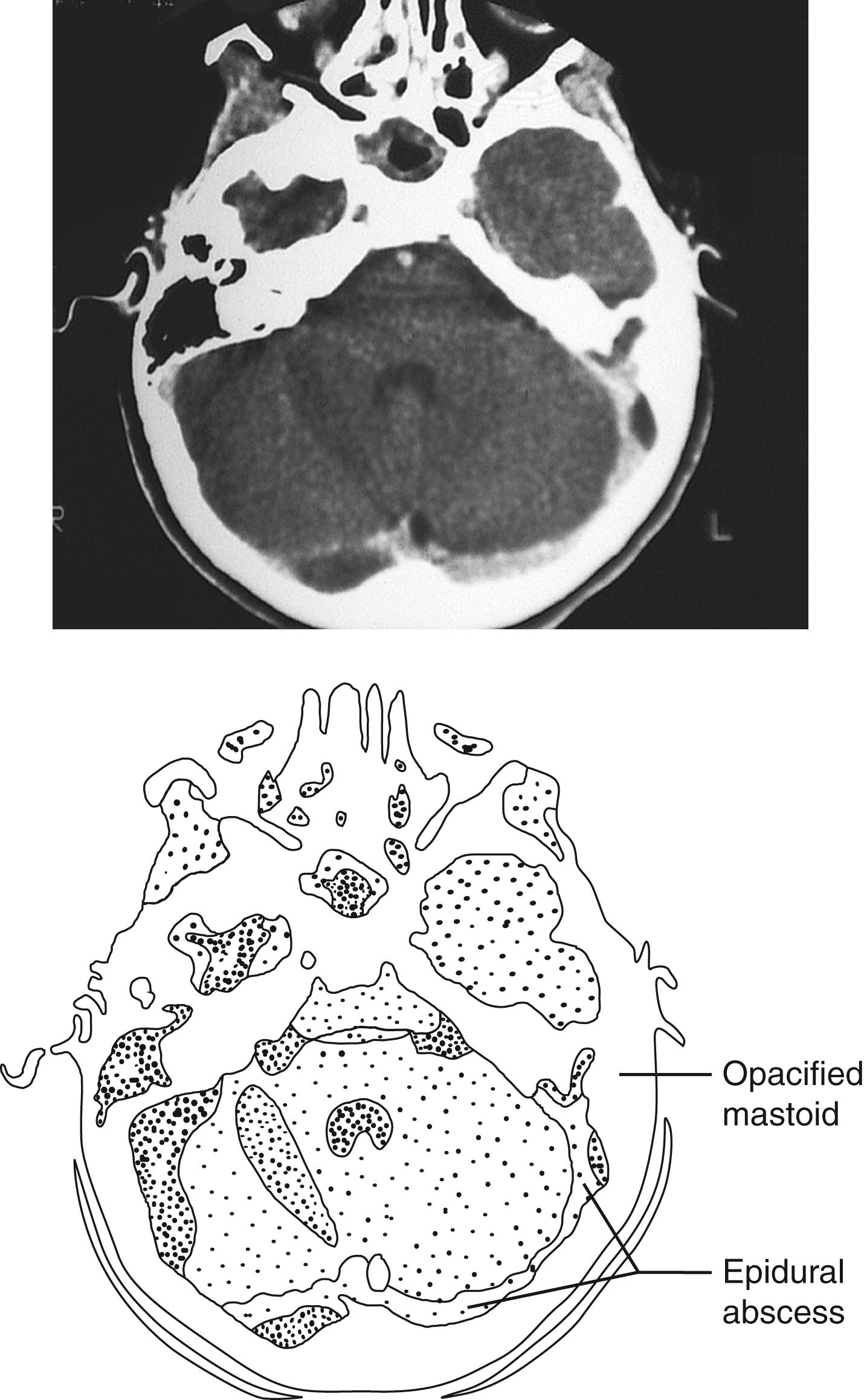
Other conditions characterized by displacement of the pinna away from the head include parotitis, primary cellulitis of the periauricular tissues, and edema secondary to insect bites or contact dermatitis. Parotitis is differentiated by finding prominent induration and enlargement of the parotid gland anterior and inferior to the external ear, together with blunting of the angle of the mandible on palpation (see Chapter 13 ). Primary cellulitis is characterized by erythema and tenderness but can often be distinguished clinically from mastoiditis by the presence of associated skin lesions that antecede the inflammation ( Fig. 24.12 ). In cases secondary to untreated external otitis or otitis media with perforation, the picture may be clinically similar. Localized contact dermatitis and angioedema may make the ear erythematous but also pruritic and nontender. The former condition is characterized by microvesicular skin changes ( Fig. 24.13 ), whereas in the latter condition, a precipitating insect bite can often be identified on inspection ( Fig. 24.14 ).
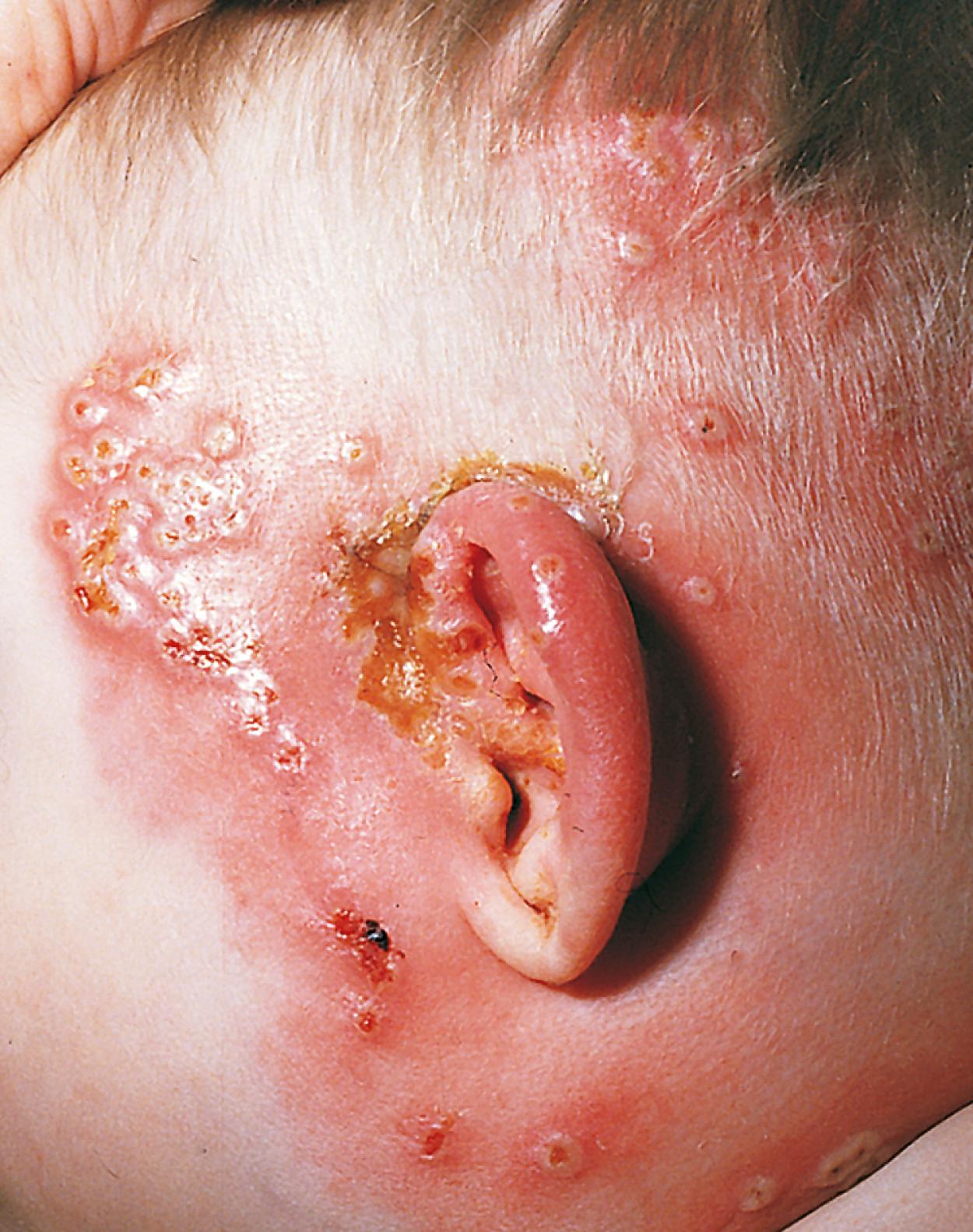
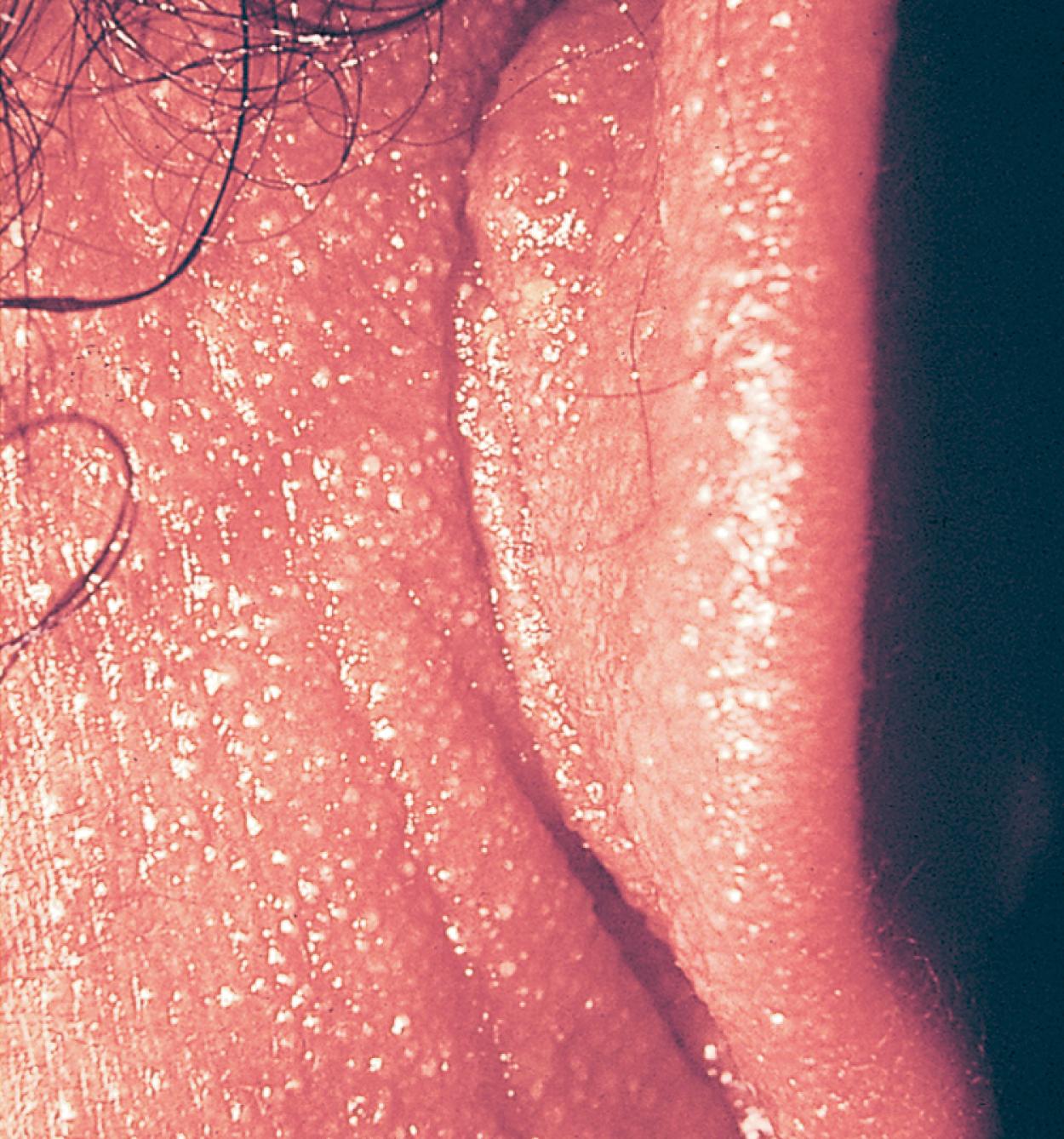
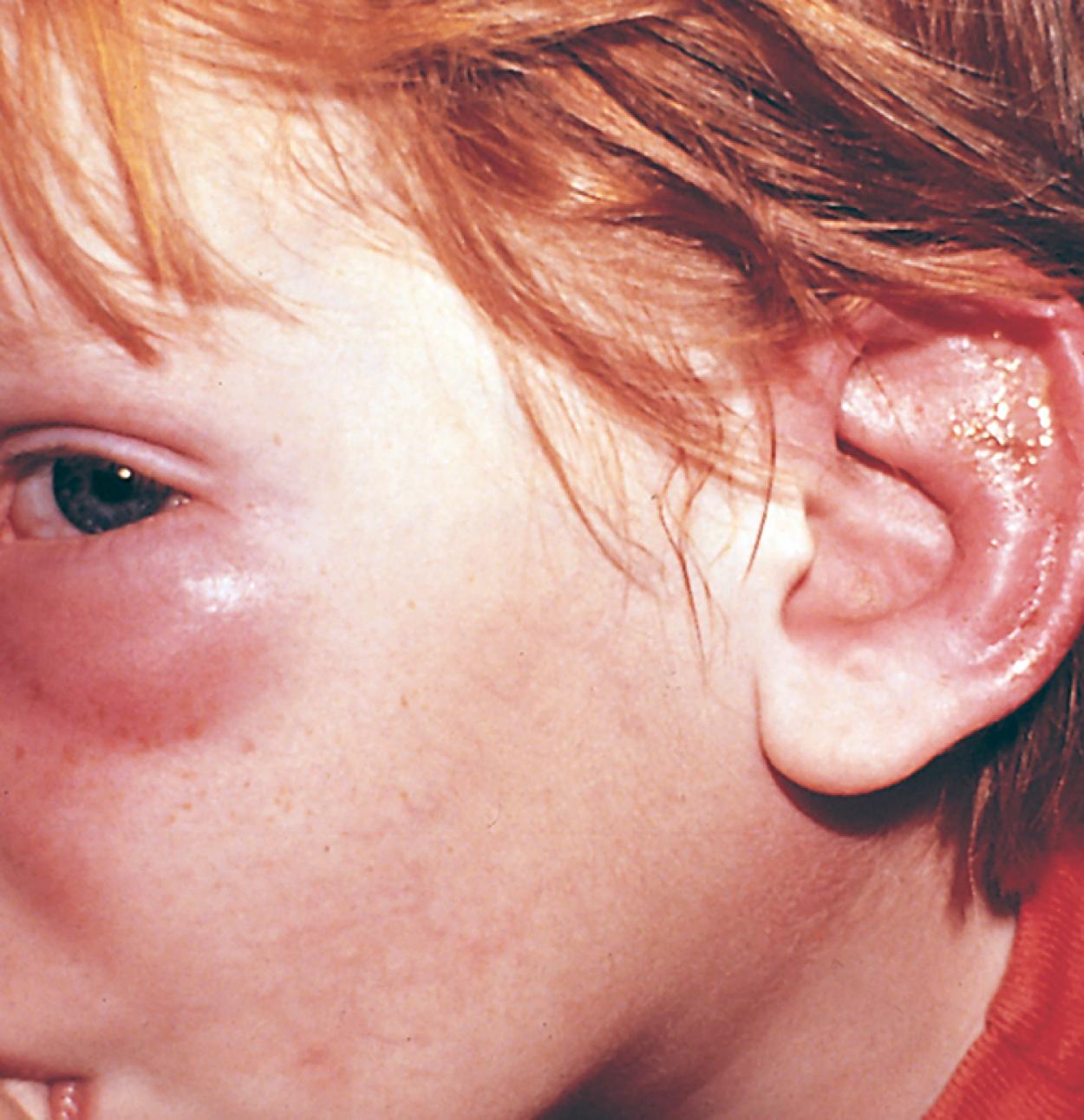
Discoloration is another important sign and is commonly a feature of conditions producing displacement. Erythema of the pinna is common when there is inflammation, with or without infection (see Figs. 24.10B and 23.12–23.14 ). Ecchymotic discoloration may be encountered with trauma. When this overlies the mastoid tip (the area immediately posterior to the pinna), it is termed a Battle sign ( Fig. 24.15A ), and usually reflects a basilar skull fracture. In such cases, the canal wall should be checked for tears and the tympanic membrane for perforation or a hemotympanum (blood behind the tympanic membrane; see Fig. 24.15B ). CT confirms the diagnosis of a basilar skull fracture. Recognition that bruising of the pinna and/or postauricular area can be a manifestation of child abuse is important (see Chapter 6 ).
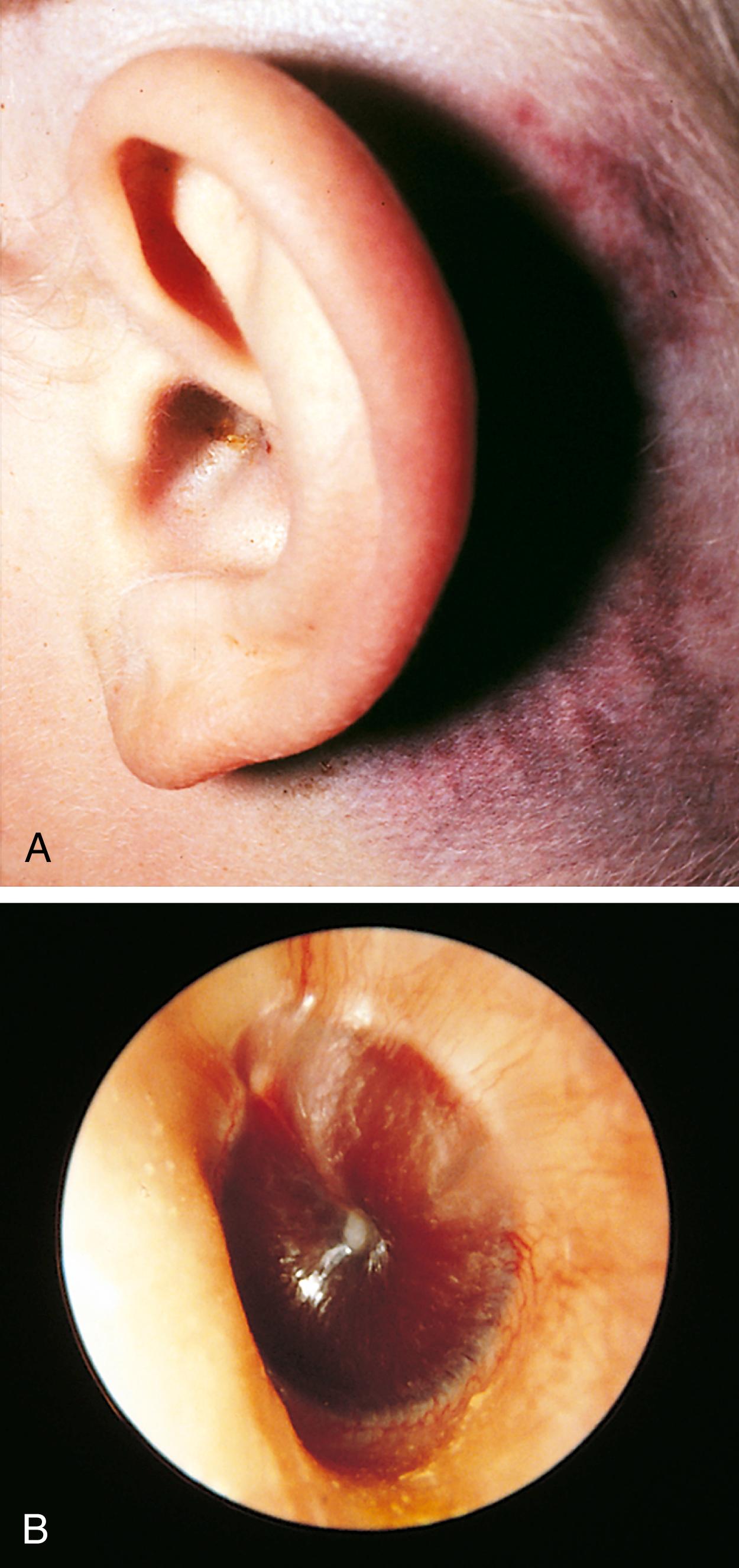
When the external ear is abnormal in shape or microtic, associated anomalies of middle ear structures are common, and hearing loss may be significant ( Fig. 24.16 ). Severe deformities stem from developmental anomalies of the branchial arches, which contribute to both external ear and middle ear structures. Such abnormalities warrant a thorough evaluation in infancy to ensure early recognition and treatment of hearing loss. Deformity of the pinna can be the result of hereditary factors or exposure to teratogens, but at times it is simply produced by intrauterine positioning. Most deformities are minor and represent isolated malformations of mostly cosmetic significance ( Fig. 24.17D ). In some instances, they may be part of a picture of multiple congenital anomalies (see Fig. 24.17A to C ; see also Fig. 24.8 and Chapter 1 ).
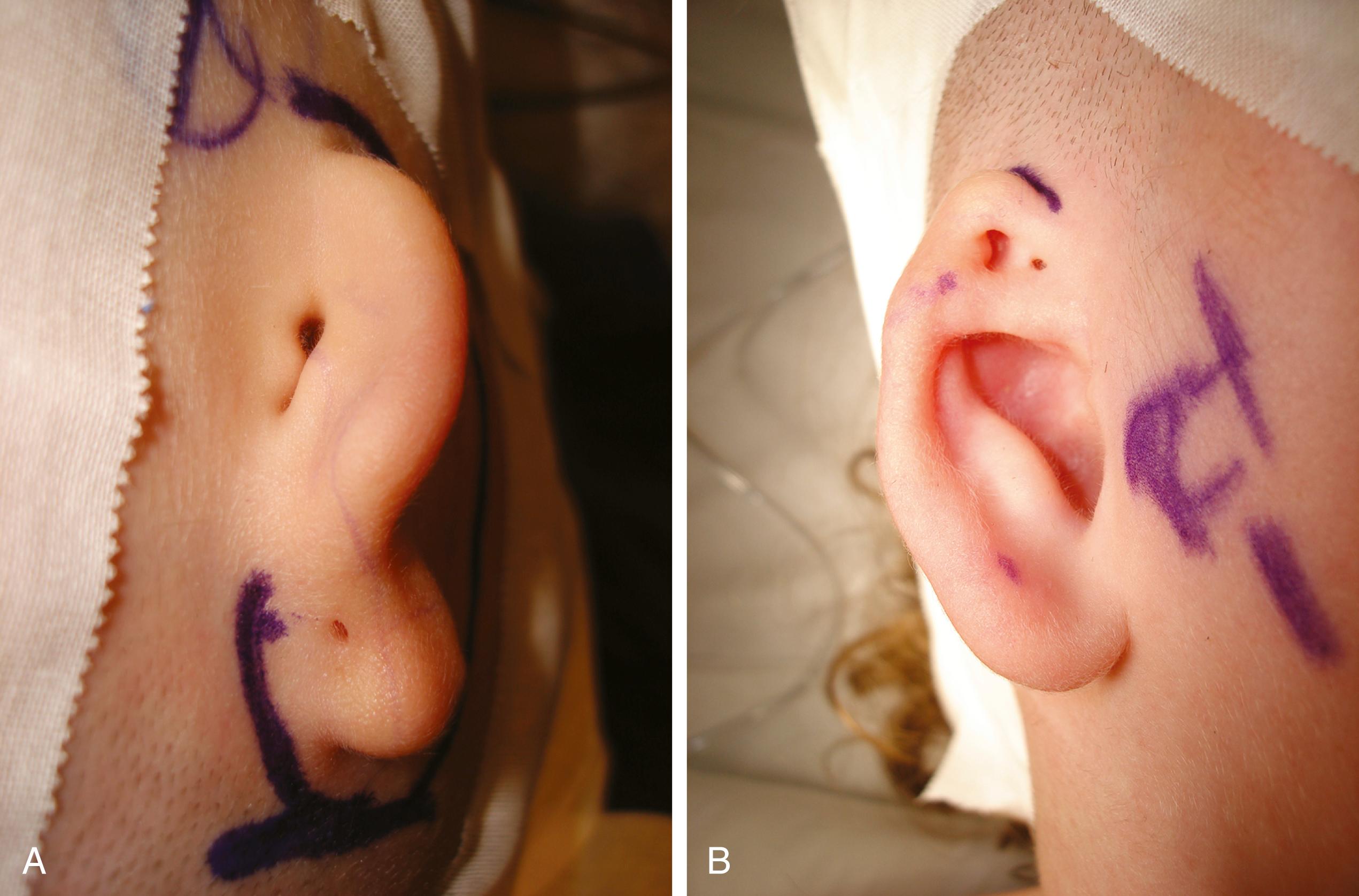
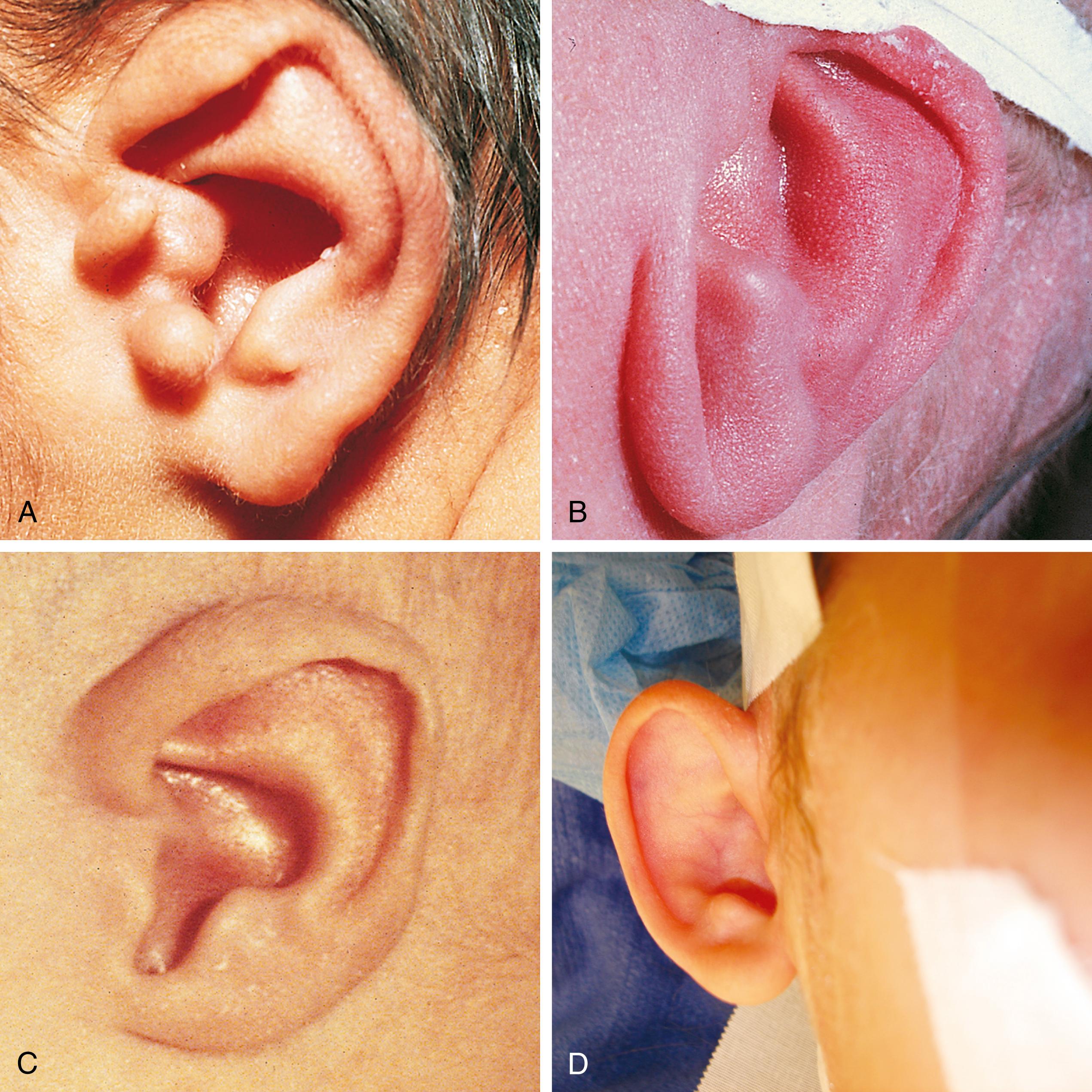
Trauma to the pinna may result in a hematoma between the skin and cartilage, the recognition of which requires otolaryngologic consultation. An unrecognized hematoma may result in a permanent deformity if left undrained, or superinfection of the hematoma. Either complications can result in permanent cosmetic damage to the pinna.
Preauricular sinuses and cysts constitute two of the more common congenital abnormalities. These are congenital remnants located anterior to the pinna with an overlying surface dimple ( Fig. 24.18A ). These cysts are vulnerable to infection and abscess formation (see Fig. 24.18B ), which necessitate needle aspiration or incision and drainage in conjunction with antistaphylococcal antibiotics. Once infection has occurred, recurrence is common unless the entire sinus is completely excised. This procedure should be undertaken once inflammation has subsided. A preauricular sinus may also result from branchio-oto-renal syndrome (also known as Melnick-Fraser syndrome ), an autosomal dominant disorder characterized by bilateral preauricular sinuses, ear anomalies, branchial cleft anomalies in the neck, and renal problems.
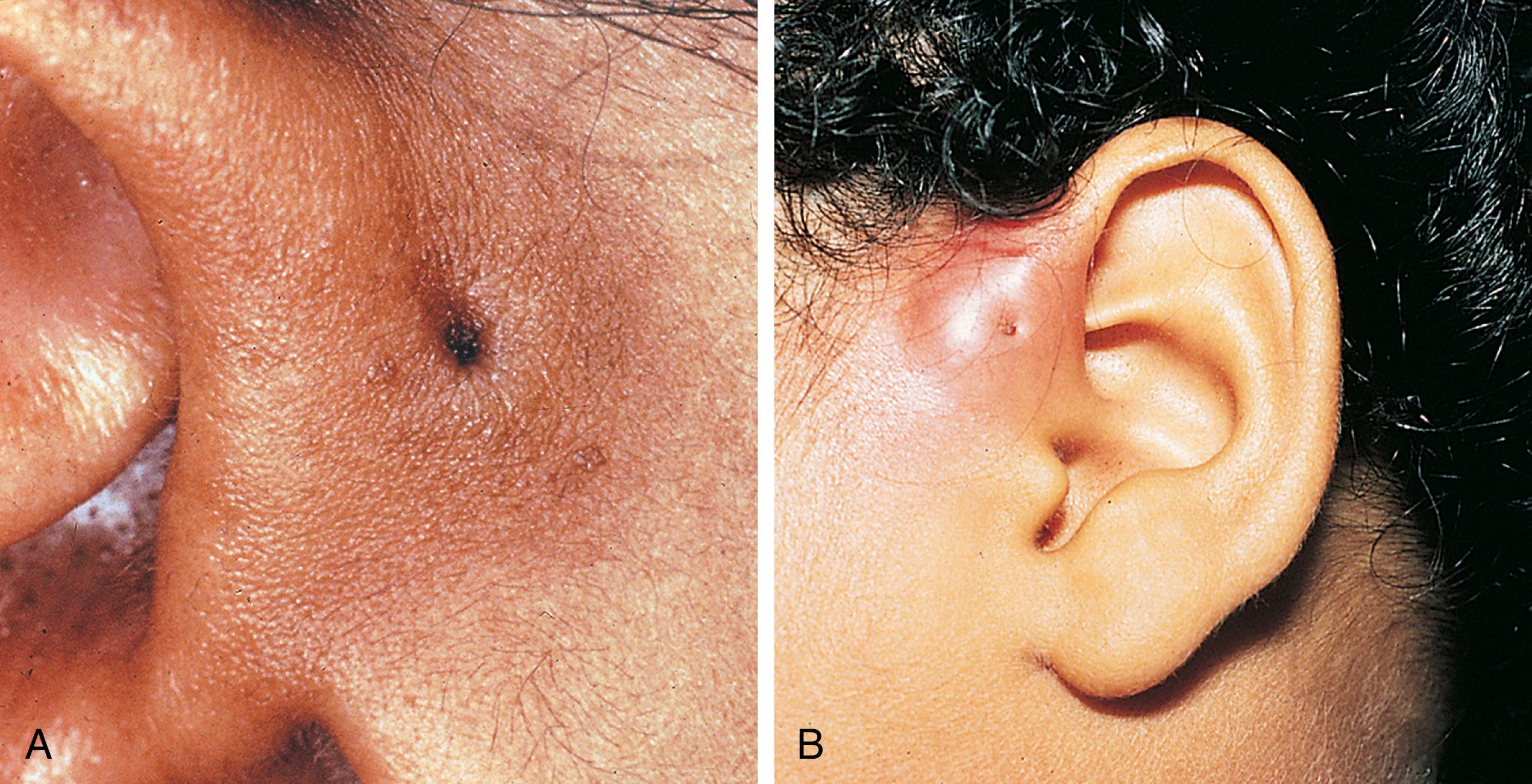
It is not unusual for children to put paper, beads, and other foreign objects into their ear canals ( Fig. 24.19A ). Small insects also on occasion may become trapped in the external ear (see Fig. 24.19B ). In some cases, small objects may be embedded in cerumen and missed on inspection. If present for more than a few days, the foreign material may stimulate an inflammatory response and result in purulent, foul-smelling obscuring the presence of the inciting foreign body. Removal of the foreign body can be accomplished by use of otologic alligator forceps or by irrigation of the ear canal; others—particularly spherical objects—require use of a Day (right angle) hook or suction (see Fig. 24.19C ; see also Fig. 24.3 ). Foreign objects may also be the cause of painful abrasions or lacerations of the external auditory canal or even a perforation of the tympanic membrane. Insertion of pencils or sticks into the ear canal by the child and parental attempts to clean the canal with a cotton swab are the most common modes of such injury.
Exposure to concussive forces such as a direct blow (which may be accidental or inflicted) or an explosion can also result in perforation ( Fig. 24.20 ). Patients with traumatic perforations must be carefully assessed for signs of injury to deeper structures. If tympanic membrane perforation occurs as a result of penetration by a foreign object or of concussive forces, the physician must be particularly aware of the possibility of middle ear or inner ear damage. Evidence of hearing loss, vertigo, nystagmus, facial nerve injury, or cerebrospinal fluid leak should prompt urgent otolaryngologic consultation.
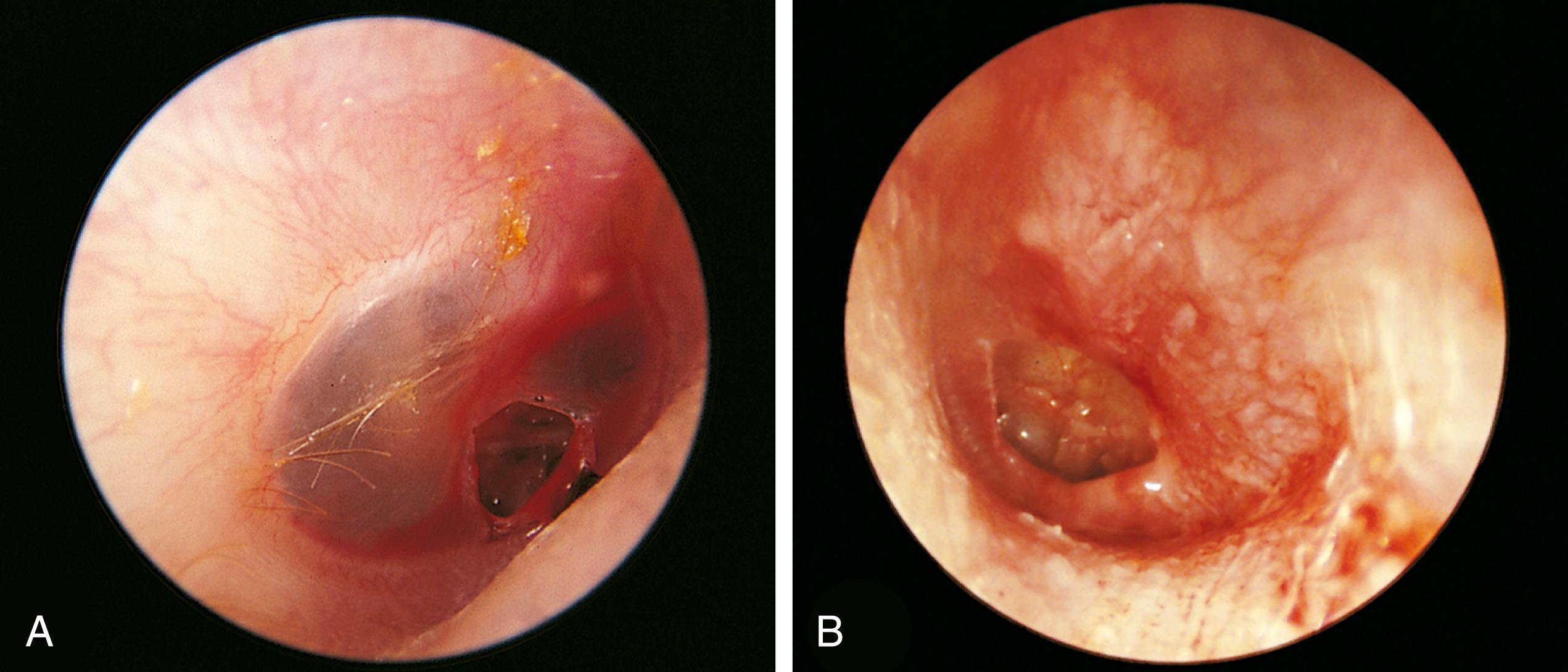
The normal tympanic membrane is thin, translucent, neutrally positioned, and mobile. The ossicles, particularly the malleus, are generally visible through the membrane ( Fig. 24.21 ). Adequate assessment of the tympanic membrane requires that the examiner note four major characteristics: (1) thickness, (2) degree of translucence, (3) position relative to neutral, and (4) mobility. Application of gentle positive and negative pressure, using a properly sealed pneumatic otoscope ( Fig. 24.22 ), produces brisk movement of the eardrum when the ear is free of disease and abnormal movement when fluid is present, when the drum is thickened or scarred, or when there is an increase in either positive or negative pressure ( Fig. 24.23 ). An abnormality in any one of the four major characteristics suggests middle ear pathology.
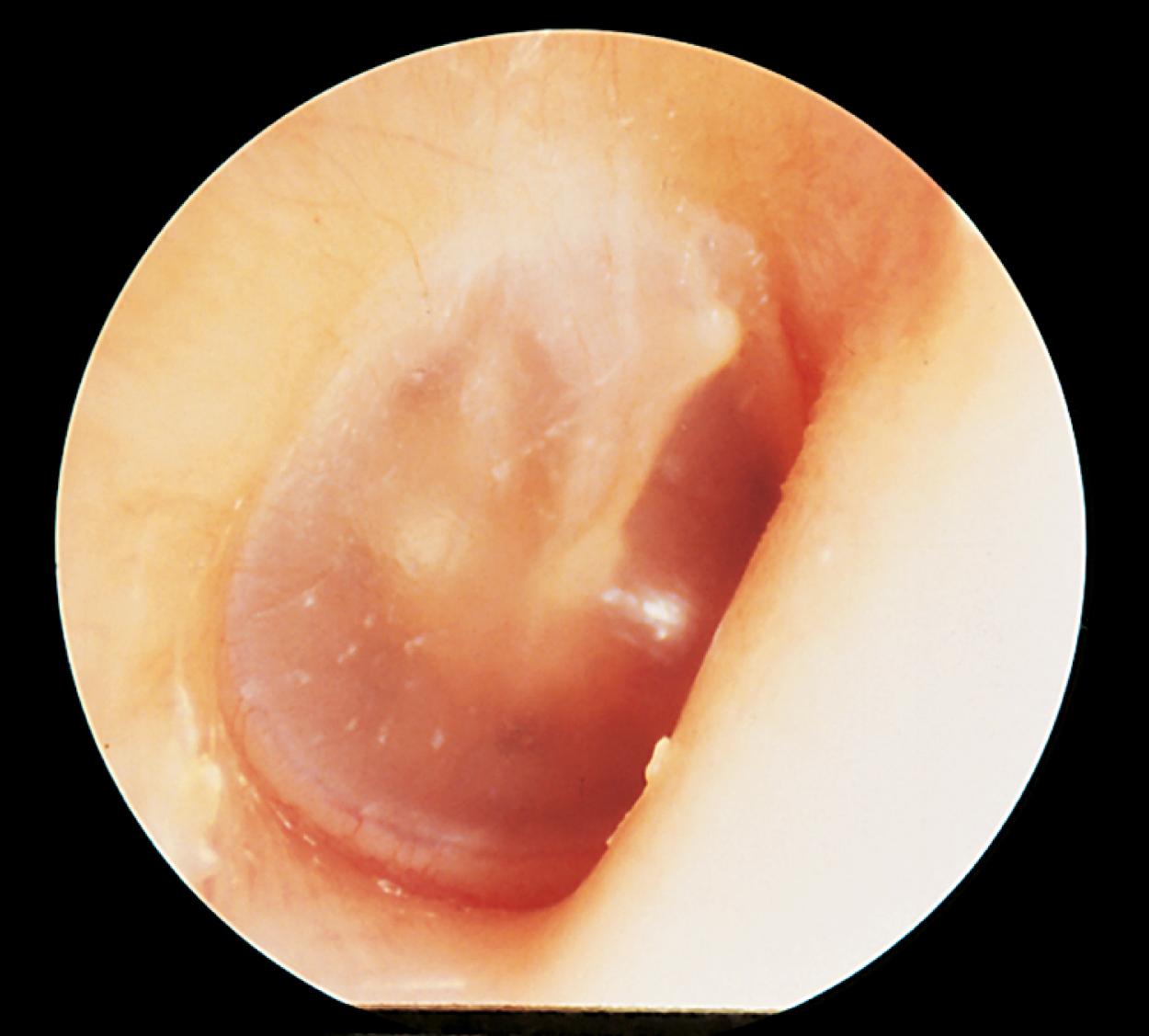
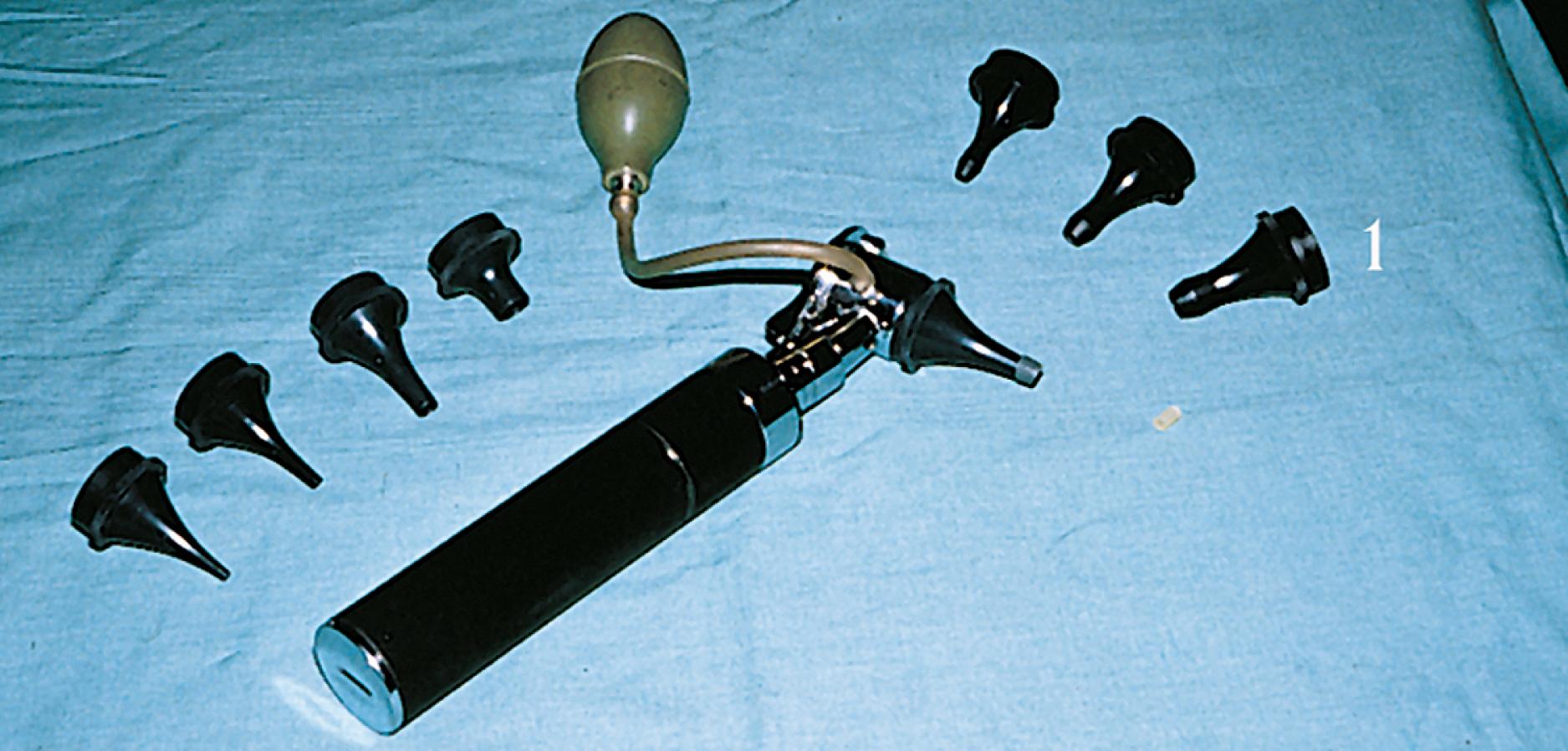
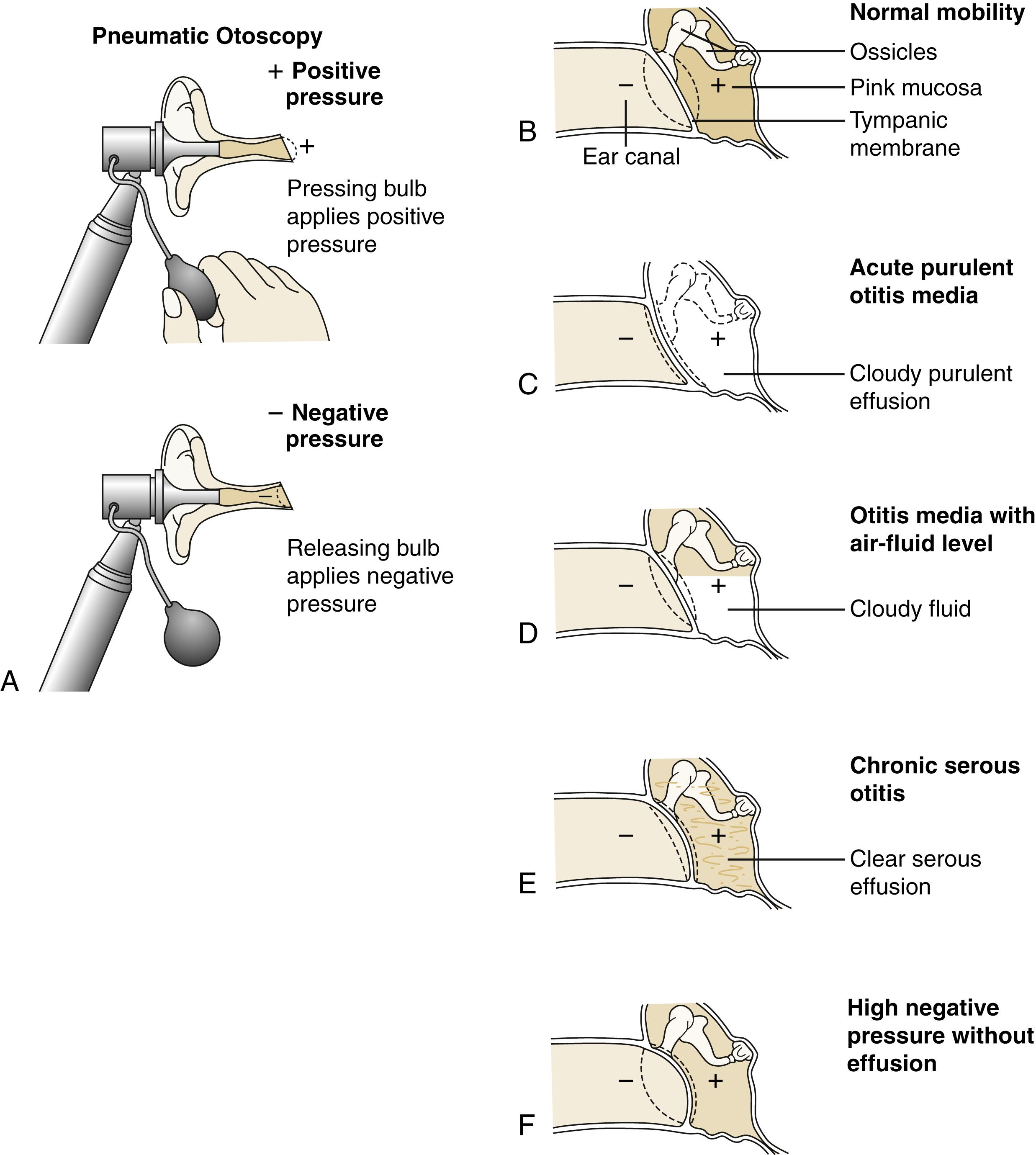
Acute otitis media is the term used to describe acute infection and inflammation of the middle ear. Associated inflammation and edema of the eustachian tube mucosa appear to play key roles in the pathogenesis by impeding drainage of the middle ear fluid. In some children, anatomic or chronic physiologic abnormalities of the eustachian tube predispose to infection. The problem is commonly seen in conjunction with an acute upper respiratory tract infection, and its onset is often heralded by a secondary temperature spike one to several days after the onset of respiratory symptoms. The major offending organisms are bacterial respiratory pathogens. The most commonly isolated organisms and their relative frequency, shown in Table 24.1 , show that Streptococcus pneumoniae and nontypeable Haemophilus influenzae are responsible for the majority of cases. Increasing rates of β-lactamase positivity in Haemophilus influenzae has balanced out a fall in rates of penicillin-non-susceptible S. pneumoniae over time, highlighting the role of high-dose amoxicillin and/or greater use of β-lactamase–resistant antibiotic regimens for empiric therapy. Sulfa drugs and clindamycin may also be useful for therapy of community-acquired methicillin-resistant Staphylococcus aureus, which is becoming increasingly common.
| Bacterial Pathogen | Number of Isolates (Percentage of Total) | Number Penicillin Resistant (Percentage) |
|---|---|---|
| Streptococcus pneumoniae | 49 (44%) | 18 (37%) |
| Haemophilus influenzae | 46 (41%) | 21 (46%) |
| Moraxella catarrhalis | 16 (14%) | 16 (100%) |
| Staphylococcus aureus | 0 (0%) | 0 (0%) |
| Total | 111 (100%) | 55 (50%) |
In acute otitis media, the classic findings on inspection of the tympanic membrane are erythema and injection; bulging that obscures the malleus; thickening, often with a grayish-white or yellow hue, reflecting a purulent effusion; and reduced mobility ( Fig. 24.24A ). However, crying produces erythema of the eardrum, and thus tympanic erythema in a crying child is of little diagnostic value. The patient is usually febrile and, if old enough, typically complains of otalgia. However, in many cases, this “textbook picture” is not seen. This is probably due in part to time of presentation, the virulence of the particular pathogen, and host factors.

Accuracy in diagnosis necessitates meticulous inspection during otoscopy and knowledge of the various modes of presentation. The challenge to clinicians is that children may present at various points during the time course of the infection. Children early in infection may have fever of a few hours’ duration and otalgia (or if very young, fever and irritability) yet have no abnormality on otoscopy. If reexamined the next day, many of these patients have clear evidence of acute otitis media. Some have erythema and bubbles or air/fluid or air/pus levels (a result of venting by the eustachian tube) without bulging and with nearly normal mobility of the eardrum (see Fig. 24.24B ). In still other cases, the drum may be full and poorly mobile with cloudy fluid behind it but with minimal erythema (see Fig. 24.24C ).
The recent guidelines from the American Academy of Pediatrics (AAP) and the American Academy of Family Practice emphasize the importance of visualizing the position of the tympanic membrane. Acute otitis media needs to be differentiated from otitis media with effusion. Although both diagnoses comprise a segment on the continuum of disease and inflammation, treatment implications vary. Otitis media with effusion does not represent an acute infection, and antibiotics should be avoided. Similarly, clinicians should not diagnose acute otitis media without the presence of a middle ear effusion, based on otoscopy or tympanometry. Moderate to severe bulging of the tympanic membrane or new onset of otorrhea not from otitis externa is diagnostic of the acute otitis media. The diagnosis may also be made with mild bulging and recent symptoms or redness of the tympanic membrane.
On occasion, the signs and symptoms of otitis media may be accompanied by the formation of a bullous lesion on the surface of the tympanic membrane, a condition termed bullous myringitis ( Fig. 24.25 ). These children usually complain of intense pain. Although this phenomenon is most commonly associated with Mycoplasma infection in adults, any of the usual pediatric pathogens in Table 24.1 can be causative in children. Finally, acute otitis media may, by virtue of increasing middle ear pressure, result in acute perforation of the tympanic membrane. On presentation, the canal may be filled with purulent material; however, tugging on the pinna usually does not elicit pain, and erythema and edema of the canal wall are minimal or absent. Cleansing with a cotton wick or suction usually reveals an inflamed drum with a barely visible perforation ( Fig. 24.26 ).
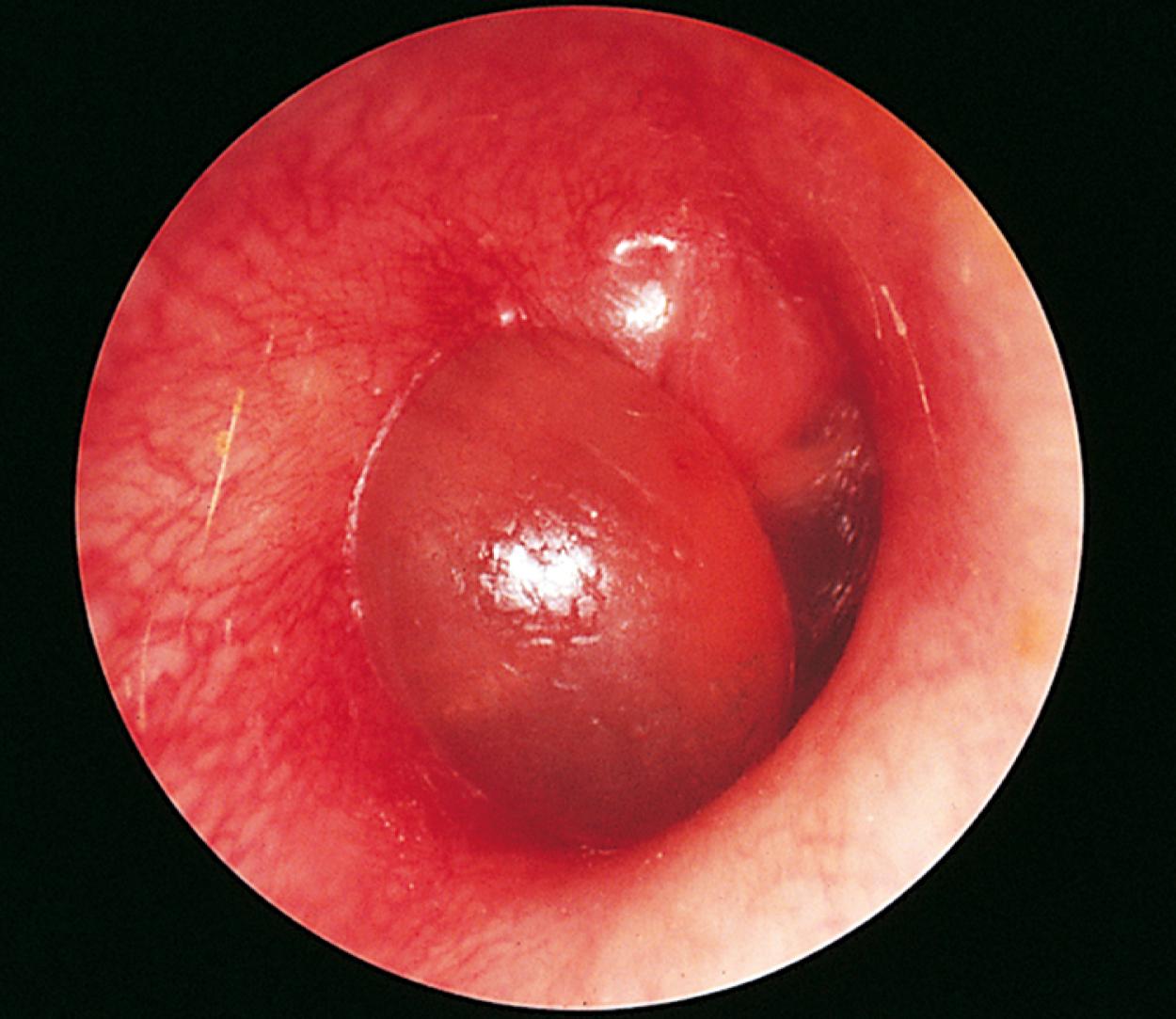
Just as clinical findings of acute otitis media vary, so do symptoms. Although some patients have severe otalgia, others may complain of sore throat, mild ear discomfort, ear popping, or decreased hearing yet have floridly inflamed eardrums. Fever may be absent.
Radiographic studies are generally of little value in the diagnosis of acute otitis media. When a temporal bone CT scan is obtained in a patient with acute otitis media and fluid in the middle ear, fluid is often present in the mastoid cavity. This will be interpreted by a radiologist as opacification of the mastoid, because it may be difficult to distinguish between the CT findings of acute otitis media and those of acute mastoiditis. In such instances, it is important that the physician looks at the patient’s clinical signs rather than rely on radiographic findings to make the diagnosis.
Treatment for acute otitis media may include the option of observation without using antibiotics based on age, illness severity, and assurance of follow-up. In addition to treating patients with an appropriate antimicrobial agent and analgesics when necessary, follow-up examination is important. This is best done 2 to 3 weeks after diagnosis, when complete resolution can be expected in more than 50% of children. The purpose of reevaluation is to identify those patients who have persistent effusions and require ongoing surveillance. Selected older patients with mild, uncomplicated acute otitis media may be observed without antimicrobial therapy, but follow-up examination is still necessary.
Children with recurrent episodes of otitis media are candidates for tympanostomy tubes. Guideline numbers of infections are three episodes in 6 months or four episodes in 1 year with one episode in the preceding 6 months.
Serous effusion in the middle ear may result from an upper respiratory tract infection, or it may be the residual of treated acute otitis. In many instances, this effusion is not spontaneously cleared but instead remains in the middle ear for weeks or months, resulting in a persistent clear gray or yellow effusion behind the eardrum ( Fig. 24.27 ). Persistence appears to result in part from eustachian tube dysfunction with poor drainage and ventilation. Pneumatic otoscopy often reveals poor mobility of the tympanic membrane, and mobility is noted primarily on negative pressure. The latter is thought to develop as a result of absorption of middle ear gases by mucosal cells, creating a vacuum that persists with the fluid because of failure of ventilation by the eustachian tube. Such long-standing effusions impair hearing.
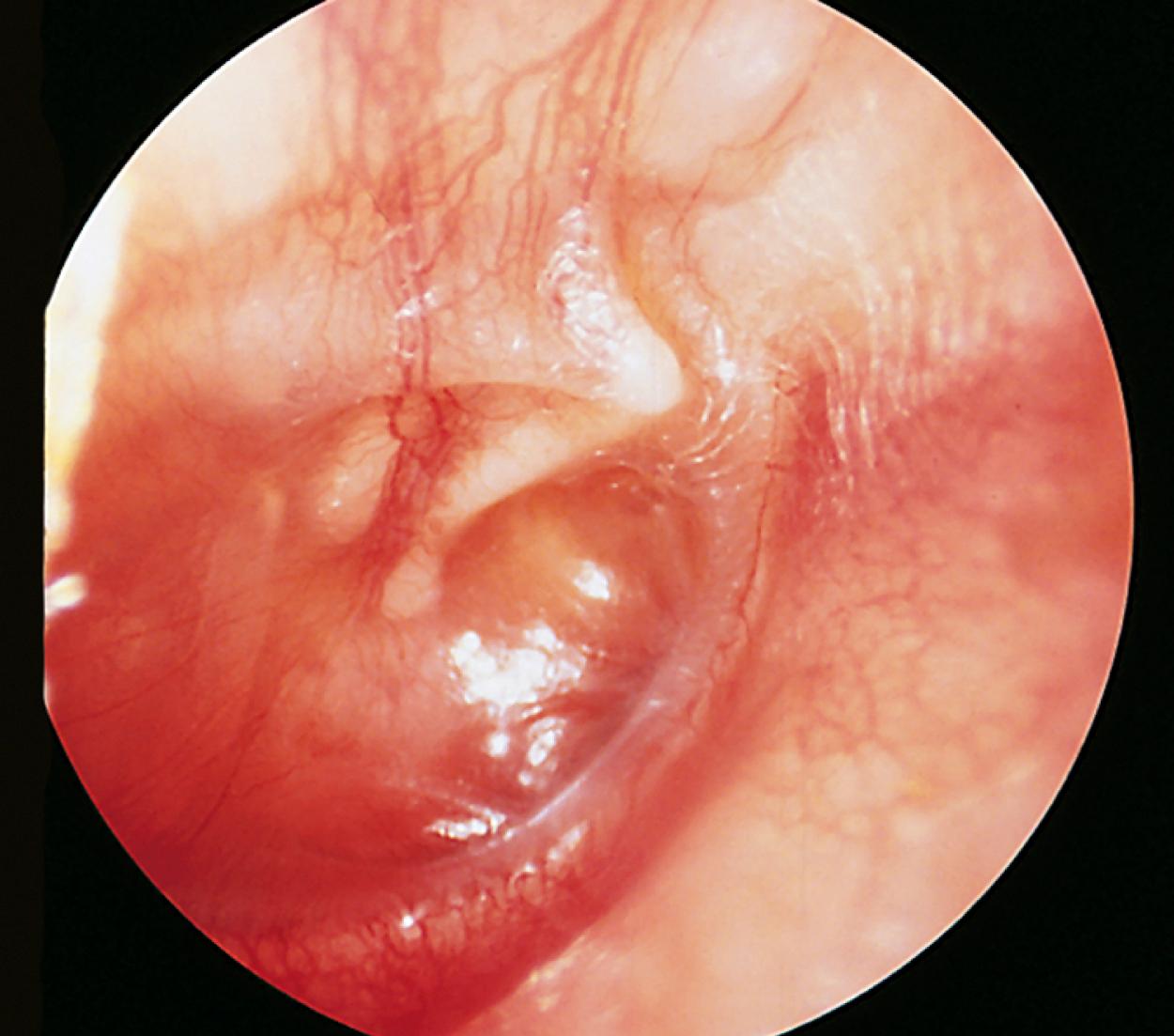
Chronic otitis media with effusion is common in young children. Patients subject to this condition appear to have significant and prolonged eustachian tube dysfunction. This “otitis-prone” state may be a seemingly isolated phenomenon, or it can be a feature of a number of syndromes characterized by palatal dysfunction or malformation or by facial hypoplasia or deformity. These conditions include cleft palate, Crouzon syndrome, Down syndrome, and the mucopolysaccharidoses and mucolipidoses (see Fig. 24.8 ; and see the Palatal Disorders section, later). Chronic obstructive adenoidal hypertrophy may also be a predisposing condition. Less commonly, immunodeficiency and immotile cilia syndrome are identified as underlying etiologic conditions.
Chronic otitis media is associated with significant morbidity in terms of intermittent or chronic hearing impairment, intermittent discomfort, and the sequelae of recurrent infection. Over months or years, the process produces permanent myringosclerotic changes in which the tympanic membrane becomes whitened, thickened, and scarred ( Fig. 24.28A ). Chronic perforations are common (see Fig. 24.28B ). Patients with persistent middle ear infections despite medical therapy, those with frequent recurrences, and children with chronic severe tympanic membrane retraction (see Fig. 24.28C ) appear to benefit from surgical drainage and insertion of tympanostomy tubes that vent the middle ear ( Fig. 24.29 ). Persistence of a serous effusion for longer than 3 to 4 months with significant hearing loss is also an indication for myringotomy and insertion of tubes. Once placed, tubes should be checked at intervals for presence and patency. Spontaneous extrusion generally occurs 6 to 24 months after insertion.

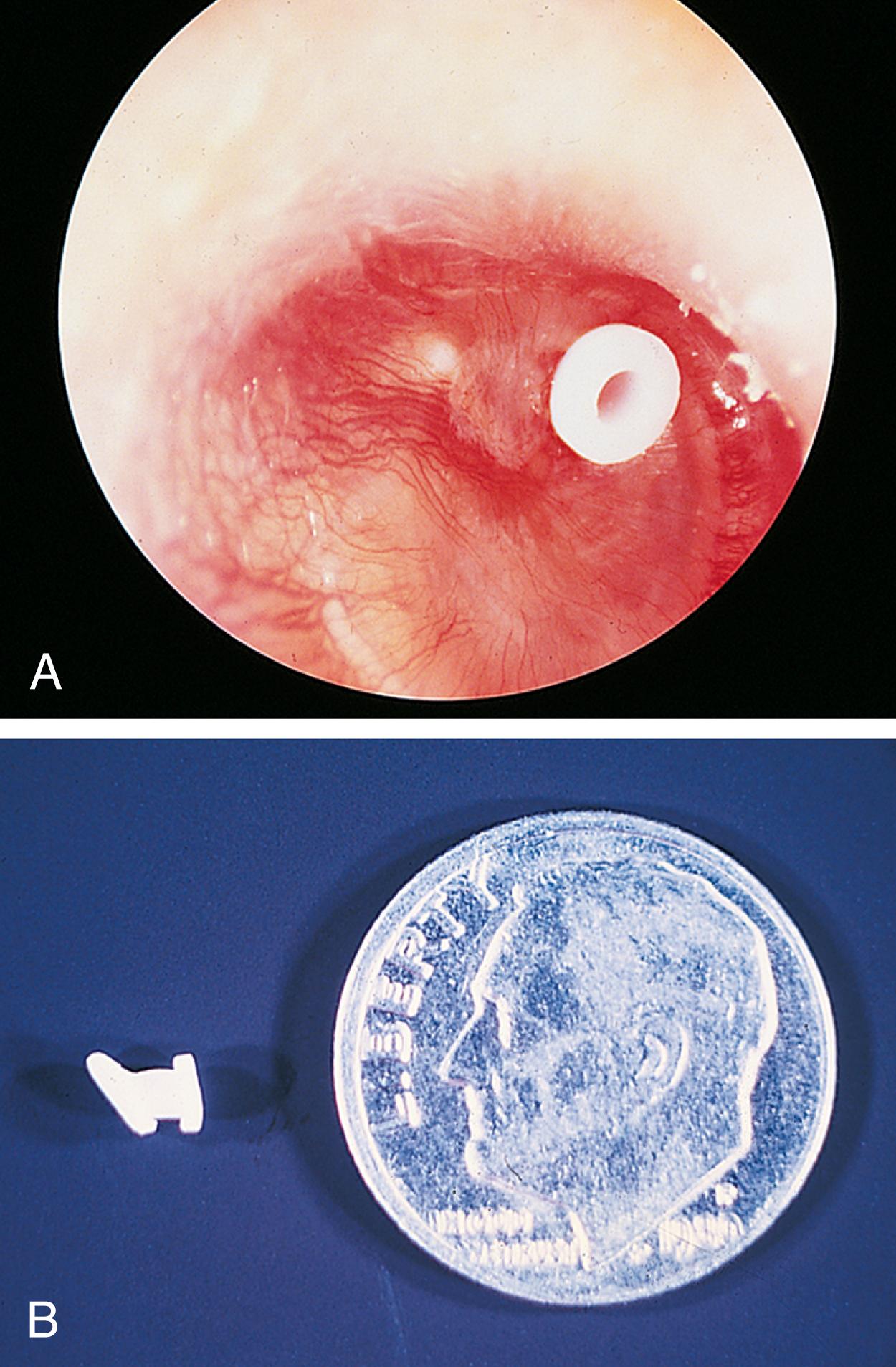
Although considerably less common than otitis media and serous otitis media, a number of other disorders involving the tympanic membrane are important because of their potential severity.
The most common and one of the most serious mass lesions of the eardrum is a cholesteatoma. It can present as a defect in the tympanic membrane through which persistent drainage occurs, or it can appear as a white cystic mass behind or involving the eardrum. It consists of trapped epithelial tissue that grows beneath the surface of the membrane ( Fig. 24.30 ). Although a few are congenital with an intact tympanic membrane, the majority are sequelae of untreated or chronic/recurrent otitis media with a tympanic membrane defect. If a cholesteatoma is not removed surgically, it continues to enlarge; becomes locally destructive; and can erode the mastoid bone, destroy the ossicles, and even invade the inner ear structures or cranium. Progressive hearing impairment is usually a feature of this condition. Congenital cholesteatoma is rare. It is seen under an intact tympanic membrane in the anterior superior quadrant of the middle ear (see Fig. 24.30D ).
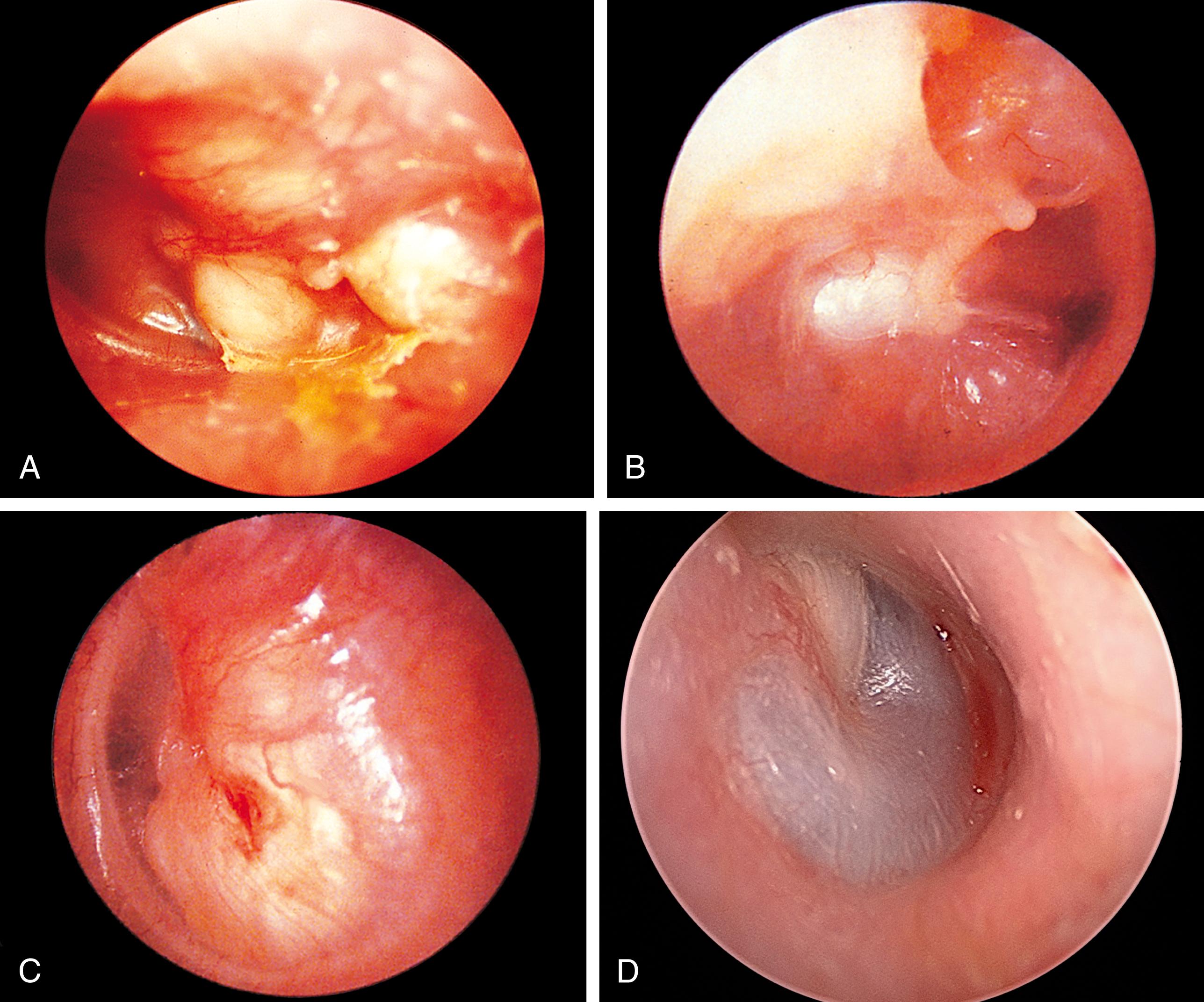
Granulomas or polyps of the tympanic membrane ( Fig. 24.31 ) can also develop in children with chronic middle ear infections. The most common cause of aural polyps in children is an old, retained tympanostomy tube. Cholesteatoma is another predisposing condition. These tissues often bleed easily, which can frighten the patient, the parent, and the physician. Left untreated, polyps can enlarge to fill the canal and by expansion can progressively damage the drum and the ossicles. Therefore, prompt surgical removal is indicated if therapy with topical and oral antimicrobials is unsuccessful.
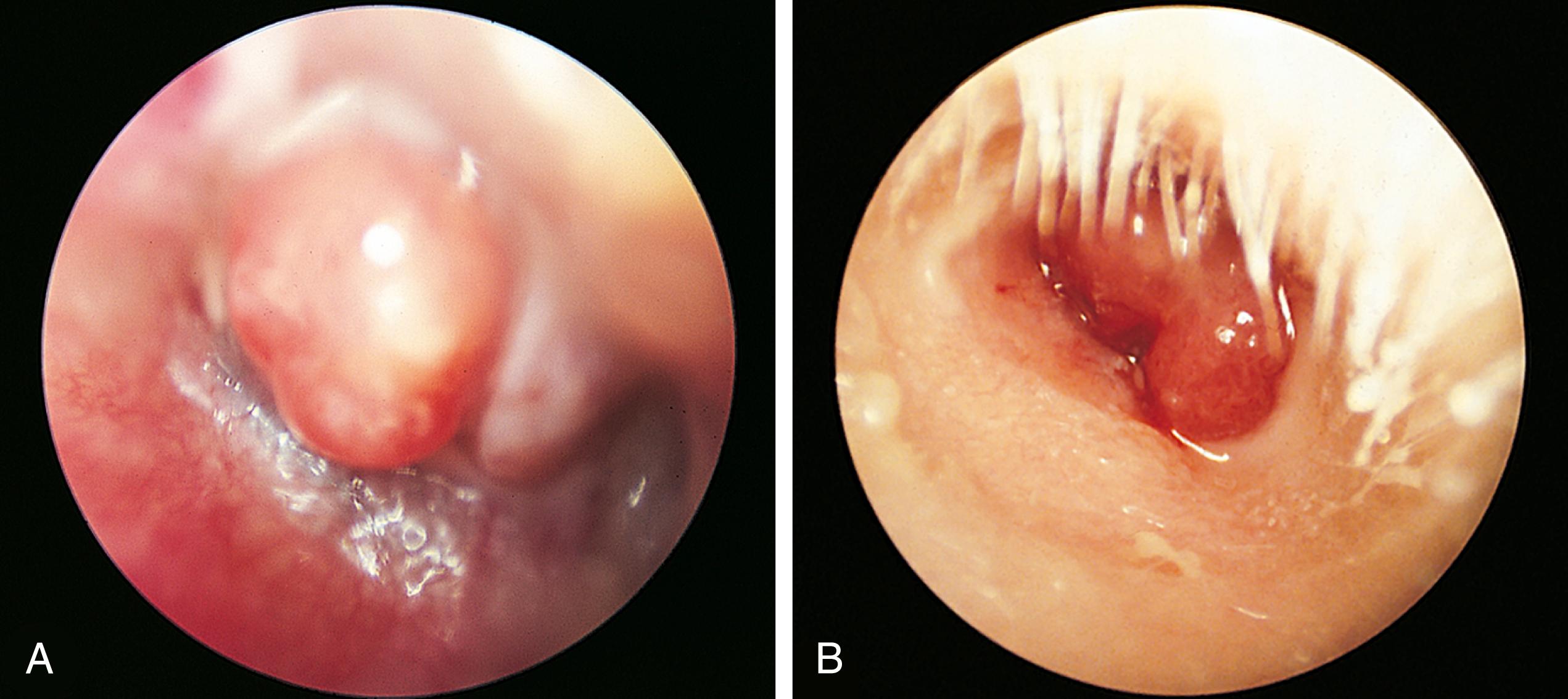
Thin, dimeric portions of the eardrum may be observed in patients with chronic middle ear disease, or they may develop after extrusion of a tympanostomy tube ( Fig. 24.32 ; see also Fig. 24.28A ). These thinned areas are the result of abnormal healing of perforations and are hypermobile on pneumatic otoscopy. The important points to note on examination are whether the full depth of the pocket is visible or partly hidden, its location with respect to the ossicles, and whether or not it is dry. If the ear canal and drum are not dry, an active infection and/or cholesteatoma is present. In cases of severe deformity, aggressive therapy including ventilation of the middle ear and surgical excision of the pocket may be necessary.
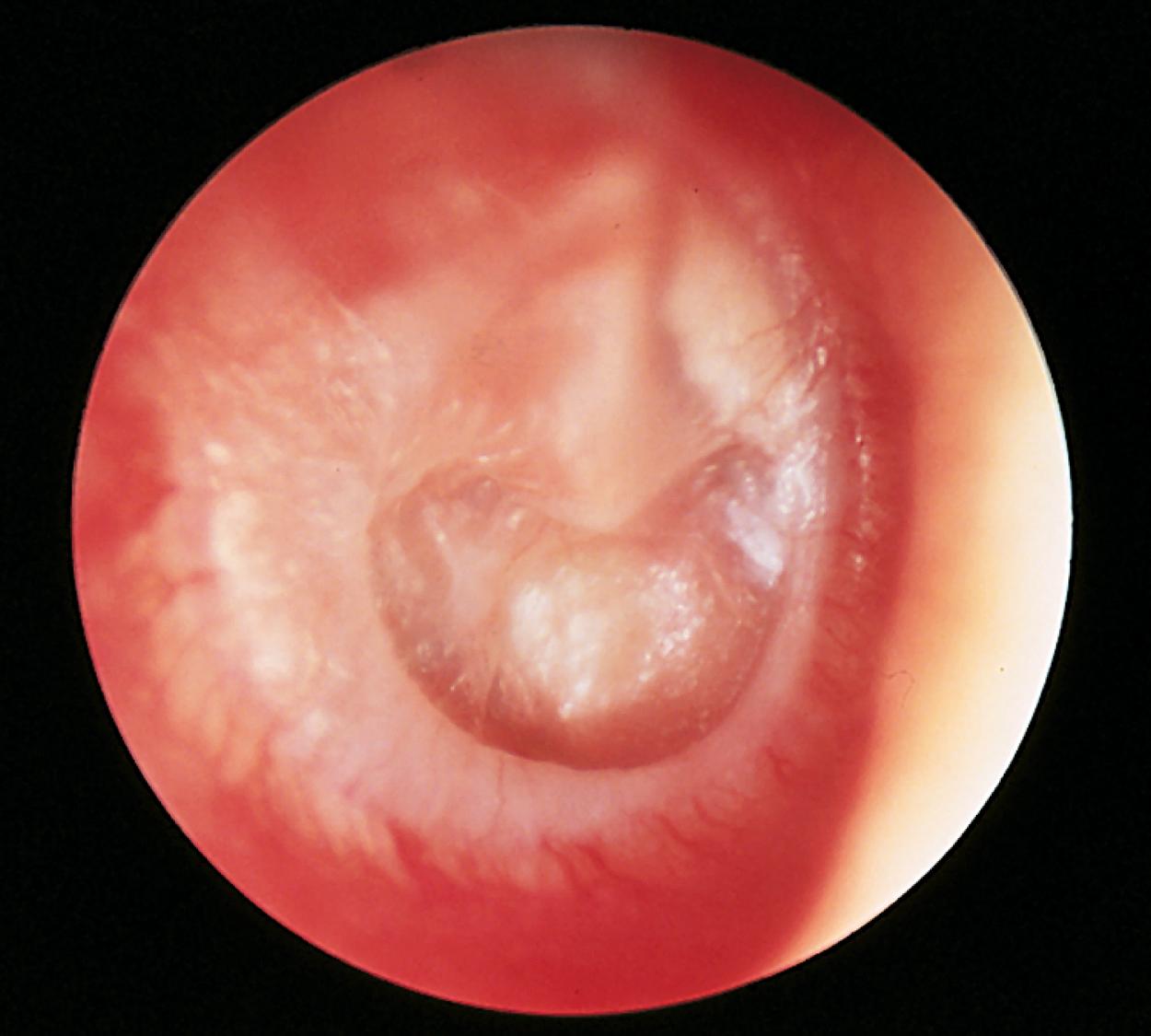
A child’s nose is examined most commonly for disturbances in external appearance, excessive drainage, or blockage of airflow and interference with breathing. Epistaxis is also frequently encountered.
Nasal examination can be difficult in younger children. It is best done with the child sitting on a parent’s lap or in a chair. The child’s head is held in a neutral position, not tilted up.
An otoscope with a wide speculum (≥4 mm) is the most practical instrument. The examiner should gently brace his or her free hand on the child’s upper lip to prevent sudden head movement from pushing the speculum tip into the nose, which could lead to nasal trauma, and should try to look toward the back of the nose rather than up into the nose. If the child is old enough to comply, he or she is asked to breathe through his or her mouth so as not to fog up the lens on the otoscope. If a nasal spreader–type speculum is used, a headlight is desirable. The septum, the anterior edges of the middle and inferior turbinates, and the nasal floor are inspected, and the quality of nasal secretions is noted. With practice and when there is minimal congestion, adenoidal size can be assessed.
A more thorough examination is possible with a nasal endoscope; this enables full visualization of internal nasal structures. Before starting, the nose is sprayed with a topical anesthetic and decongestant to shrink the nasal mucosa. With patience, older children can be coaxed through the insertion and examination. Allowing them to hold and inspect the device, test the light, look at themselves on the monitor, and even insert the tip into their nose assists cooperation ( Fig. 24.33 ). Most children younger than 5 years old require immobilization, either on a papoose board or with parental and nursing assistance. The nasal endoscope is a useful tool, and this type of examination can be done readily in the otolaryngologist’s office.
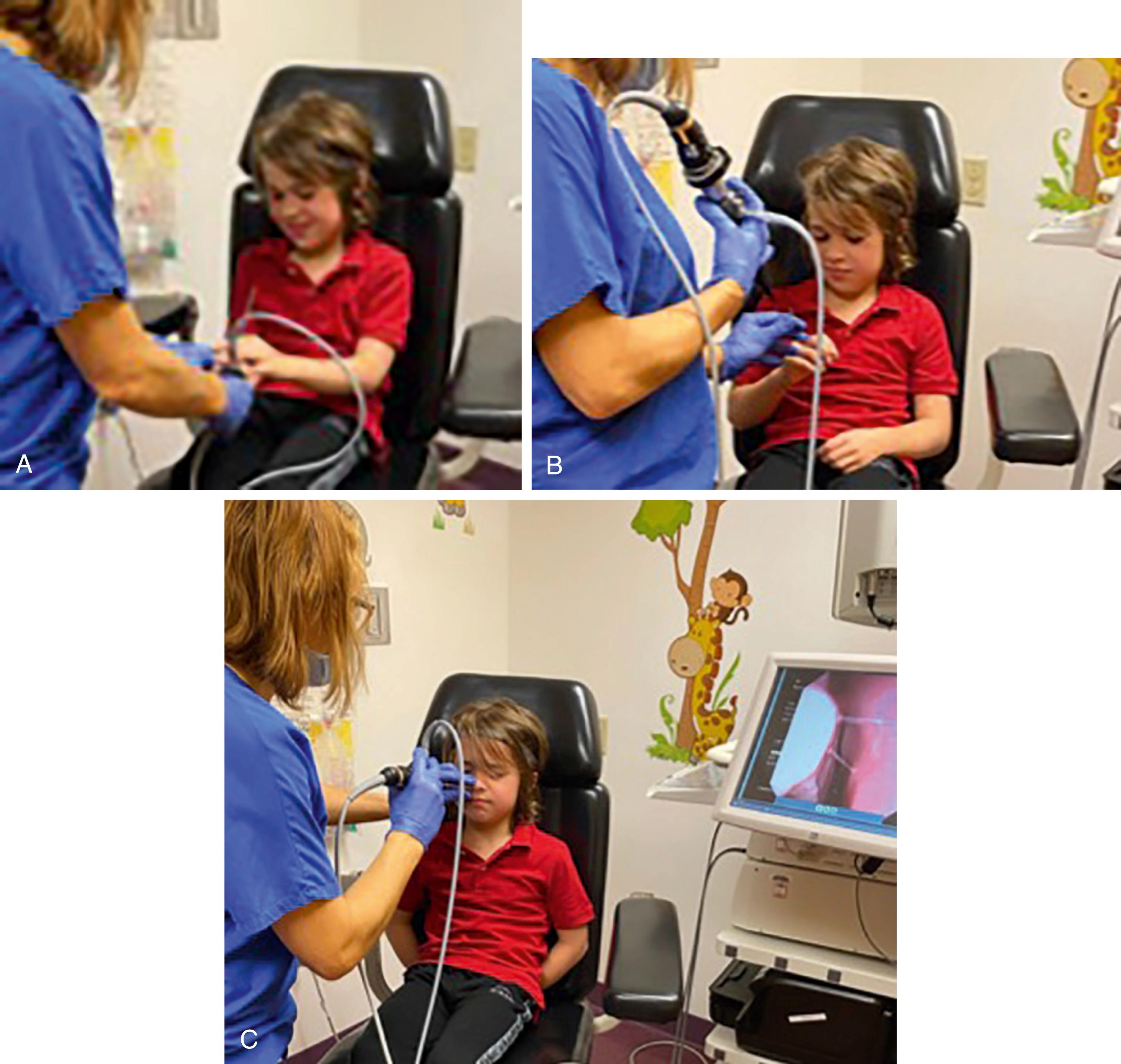
In infancy and early childhood, the nasal passages are small and easily obstructed by processes that produce mucosal edema and coryza. Causes of increased nasal mucosal edema and/or rhinitis include maternal circulating hormones, reflux, environmental irritants or allergens, dried secretions, suction trauma, and infections. In the first 3 months, infants are obligate nose breathers and therefore can have significant respiratory distress from nasal congestion alone. Nasal congestion of any etiology can then result in disruption of an infant’s suck-swallow-breathe pattern, which in turn can worsen reflux and aerophagia and subsequently lead to increased agitation and worsened nasal congestion. These secondary problems can be minimized by instructing parents to hold these infants up on their shoulders and burp them for 10 to 15 minutes after feedings. Instillation of liberal saline nasal drops to loosen secretions, followed by nontraumatic nasal suctioning before meals and naps, also provides a measure of relief. Oral decongestants are ineffective and often produce marked irritability when given to infants in the first year of life; they are no longer approved for pediatric use because of serious adverse events including deaths in children younger than 2 years old. Fortunately, upper respiratory tract infections are generally brief and clear within a few days.
On occasion, infants with upper respiratory tract infection go on to have persistent, purulent, or serosanguinous nasal discharge. Culture of discharges persisting longer than 10 to 14 days may disclose heavy growth of a single pathogen. Preliminary studies of empirical antimicrobial therapy in such infants suggest that this produces rapid and effective resolution of symptoms when compared with a placebo. Thus, this picture of prolonged nasal discharge probably represents a bacterial ethmoiditis or nasopharyngitis, the infant equivalent of sinusitis and warrants systemic or topical therapy.
Gastroesophageal reflux disease (GERD), environmental irritants (tobacco, dust, pollution, etc.), allergies (both inhaled and ingested), bacteria, and viruses cause nasopharyngeal inflammation, nasal congestion, and rhinorrhea. In infants with GERD, gastric contents being repetitively regurgitated into the nasopharynx result in varying degrees of mucosal inflammation and edema. Similarly, food sensitivities or true allergies can result in increased gastric distress with increased reflux and mucosal inflammation secondary to systemic allergen exposure. Lastly, palatal abnormalities or uncoordinated feeding can result in nasal regurgitation of food and saliva, which in turn results in rhinitis. Snoring and/or coughing during sleep as well as stertor and dysphagia are common associated symptoms. Although vomiting or frequent spitting, sometimes with passage of regurgitated material through the nose, may be reported, often such symptoms are absent. Diet modification and use of nasal saline, followed by conservative and nonpharmacologic reflux interventions are the first line of therapies.
Congenital causes of nasal obstruction include pyriform aperture stenosis, midnasal stenosis, choanal atresia/stenosis, and congenital masses, such as tumors, cysts, and polyps.
Congenital nasal pyriform aperture stenosis (CNPAS) is a narrowing of nasal passage at the level of the pyriform aperture secondary to medial position of the maxillary processes. A pyriform aperture measuring less than 11 mm on radiographic imaging (CT maxillofacial scan preferred) is considered stenotic ( Fig. 24.34A ). Clinically, CNPAS presents as nasal congestion, respiratory distress which worsens with feeding and is relieved with crying, difficulty passing 5 mm suction catheters or difficulty passing 2.9 mm flexible nasolaryngoscopes. Symptoms may be absent until the acquisition of an URI or other forms of acquired nasal congestion. On exam, the nares often are V-shaped, the anterior palate is triangular, and a central medial incisor may be noted on radiographic imaging (see Fig. 24.34B ). An MRI brain is recommended after diagnosis of CNPAS with medial incisor as it may be associated with holoprosencephaly and pituitary anomalies. Given the medial positioning of the maxillary processes in CNPAS, mid nasal stenosis is commonly also present and may need to be addressed.
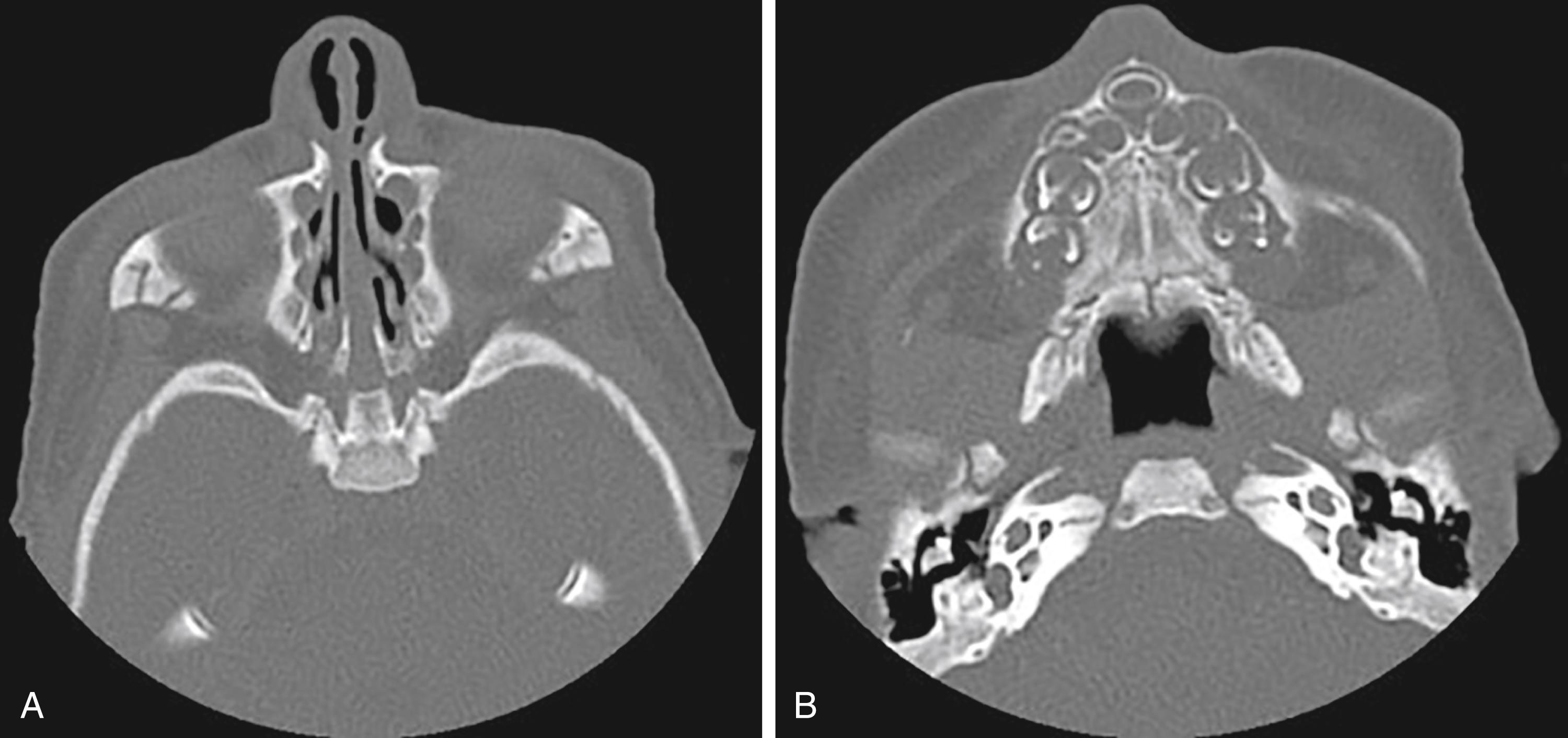
Treatment options for CNPAS include nasal saline, nontraumatic suctioning, use of a McGovern nipple, and surgical interventions. Mild cases will improve with growth of the infant and are likely not to require surgical intervention.
Choanal atresia may be bony (90%) or membranous (10%), bilateral or unilateral. Newborns with bilateral choanal atresia manifest severe respiratory distress at delivery, with cyanosis that is relieved by crying and returns with rest (paradoxical cyanosis). The true nature of the problem can elude detection if the physician relies solely on passing soft feeding catheters through the nose to determine patency, because these can buckle or curl within the nose. A diagnosis is best made with a van Buren urethral sound or a firm plastic suction catheter (both No. 8 French). This is passed gently along the floor of the nose, close to the septum. If resistance is encountered, the diagnosis of choanal atresia is suspected ( Fig. 24.35A ) and can be confirmed by endoscopy or by obtaining a CT scan of the nose and nasopharynx with fine overlapping cuts (see Fig. 24.35B ).
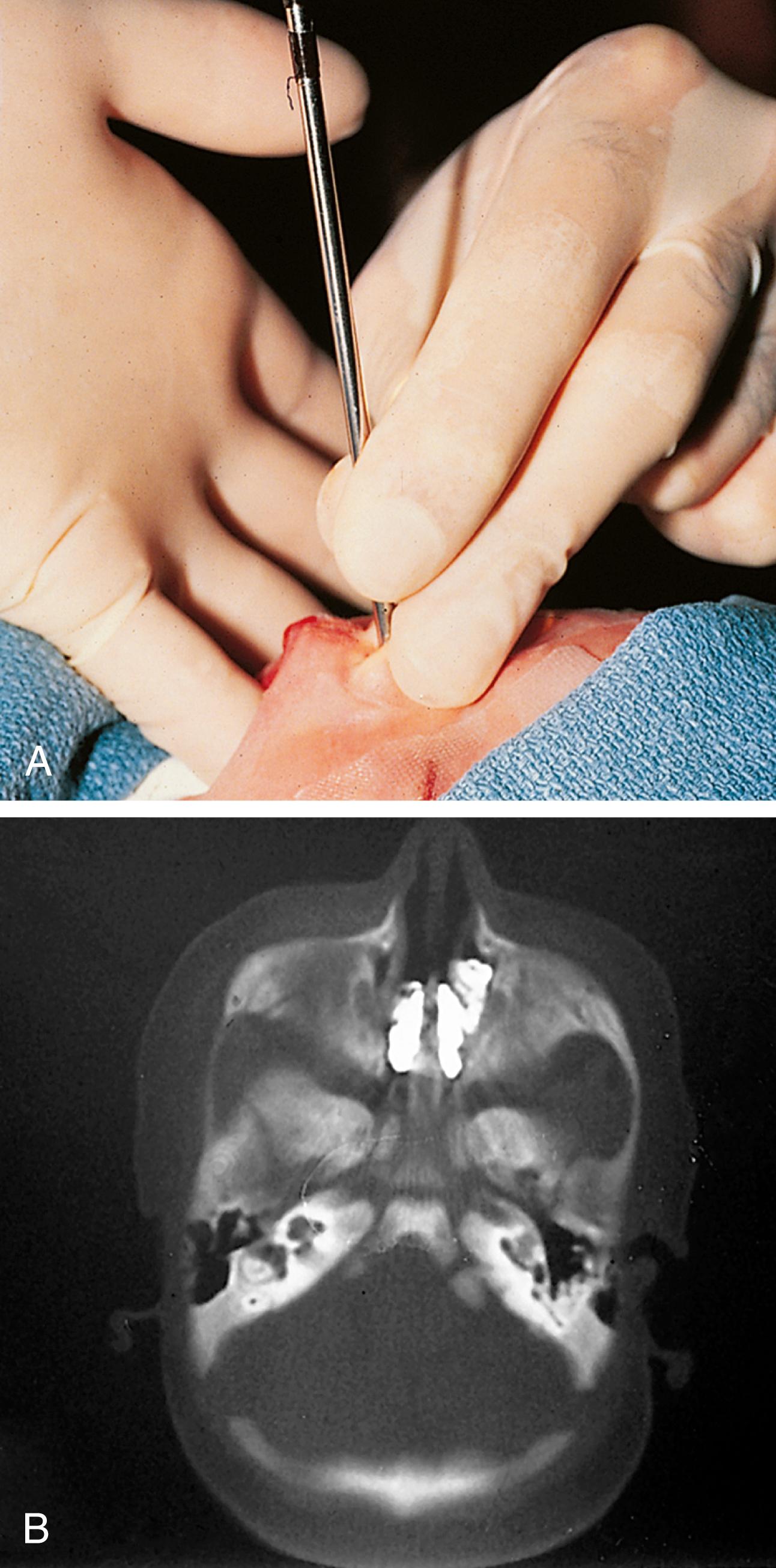
Immediate relief of neonatal respiratory distress from bilateral choanal atresia may be accomplished by insertion of an oral airway (or a firm nipple from which the tip has been cut away) into the mouth. Definitive studies can then be performed to aid in planning surgical correction. Infants with unilateral choanal atresia ( Fig. 24.36 ) are usually asymptomatic at birth; however, with time they develop a persistent unilateral nasal discharge. Bilateral atresia requires earlier surgical intervention.
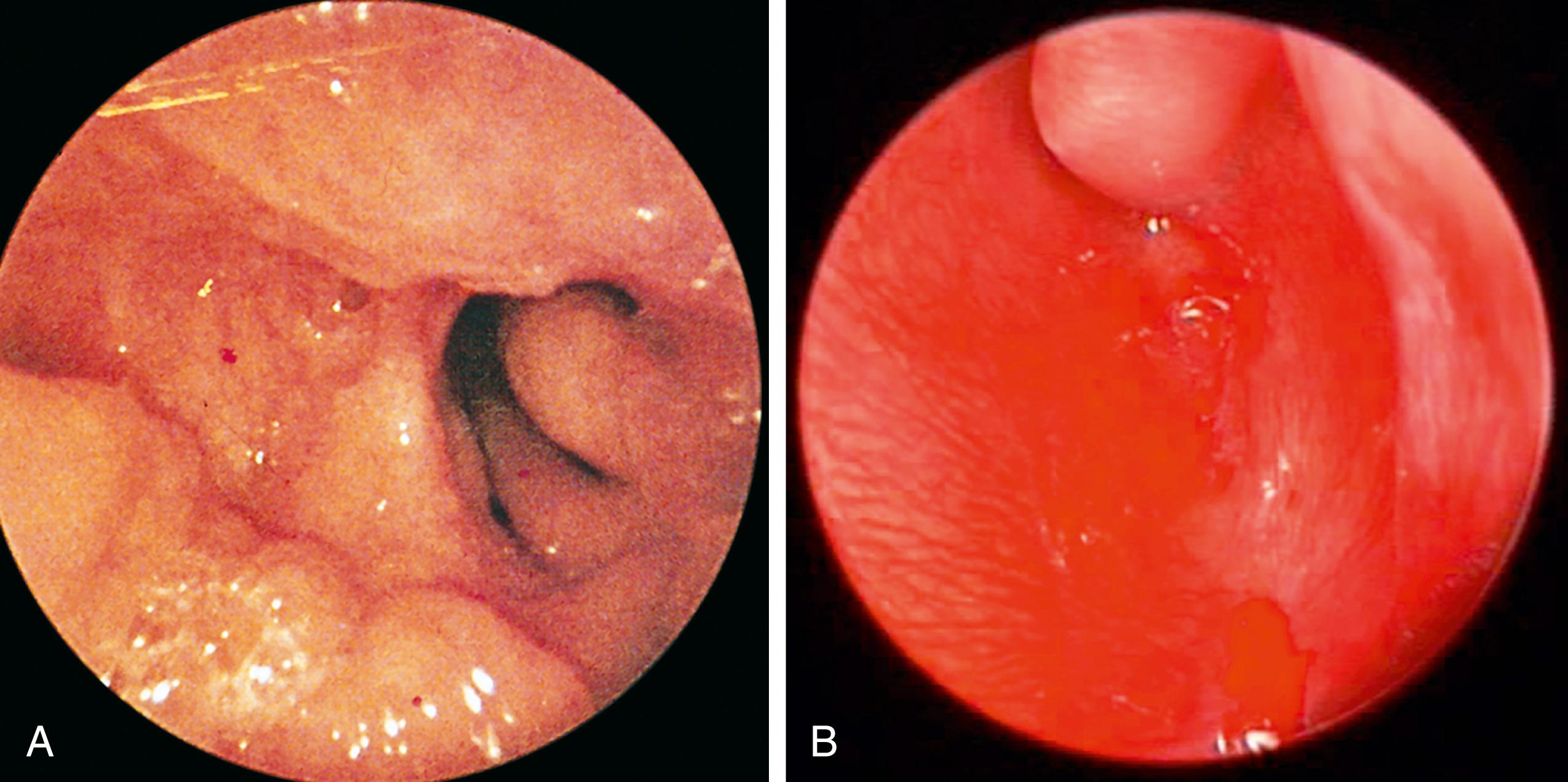
Choanal stenosis and/or pyriform aperture stenosis may be asymptomatic in the newborn period, but acquisition of an upper respiratory tract infection can result in significant respiratory compromise. When stenosis is suspected, nasal endoscopy or CT scan is indicated. In most cases, symptomatic therapy using saline nose drops and nontraumatic suctioning is sufficient to help the infant through the upper respiratory tract infection. With growth, the problem usually abates, but in some cases, surgery may be required.
Congenital mass lesions are another source of nasal obstruction. These are particularly likely to become apparent during the first 2 years of life. The modes of presentation vary; some lesions are manifest primarily by symptoms of obstruction and are detected by diagnostic radiography; others become visually evident within a nostril or as a subcutaneous mass located near the root of the nose. On occasion, these patients have recurrent nasal infections and/or epistaxis. All such masses merit thorough clinical and radiographic evaluation, because many have intracranial connections.
An encephalocele is an outpouching of brain tissue through a congenital bony defect in the midline of the skull. Some patients have craniofacial deformities and a rounded subcutaneous swelling between the eyes or adjacent to the nose. In other instances, the neural tissue prolapses into the nasal cavity or nasopharynx, resulting in signs and symptoms of nasal obstruction without obvious external anomalies ( Fig. 24.37A ). On occasion, a grape-like mass may be seen within the nares or protruding into the back of the mouth. The mass is usually identified by diagnostic radiography. CT (see Fig. 24.37B ) is particularly helpful in delineating the extent of the mass and the underlying bony defect. Repair requires a collaborative effort by specialists in otolaryngology, neurosurgery, and in some cases, plastic surgery.

Nasal dermoids are embryonic cysts containing ectodermal and mesodermal tissue. They present as round, firm subcutaneous masses located on the dorsum of the nose, close to the midline ( Fig. 24.38A ). Examination of the overlying skin frequently reveals a small dimple, at times with extruding hair. Some of these cysts have deep extensions down to the nasal septum or through the cribriform plate into the cranium. Thorough evaluation by axial and coronal CT scans and MRI is necessary to determine extent and to plan repair (see Fig. 24.38B and C ). If such cysts are not removed, secondary infection is common and often results in fistula formation.
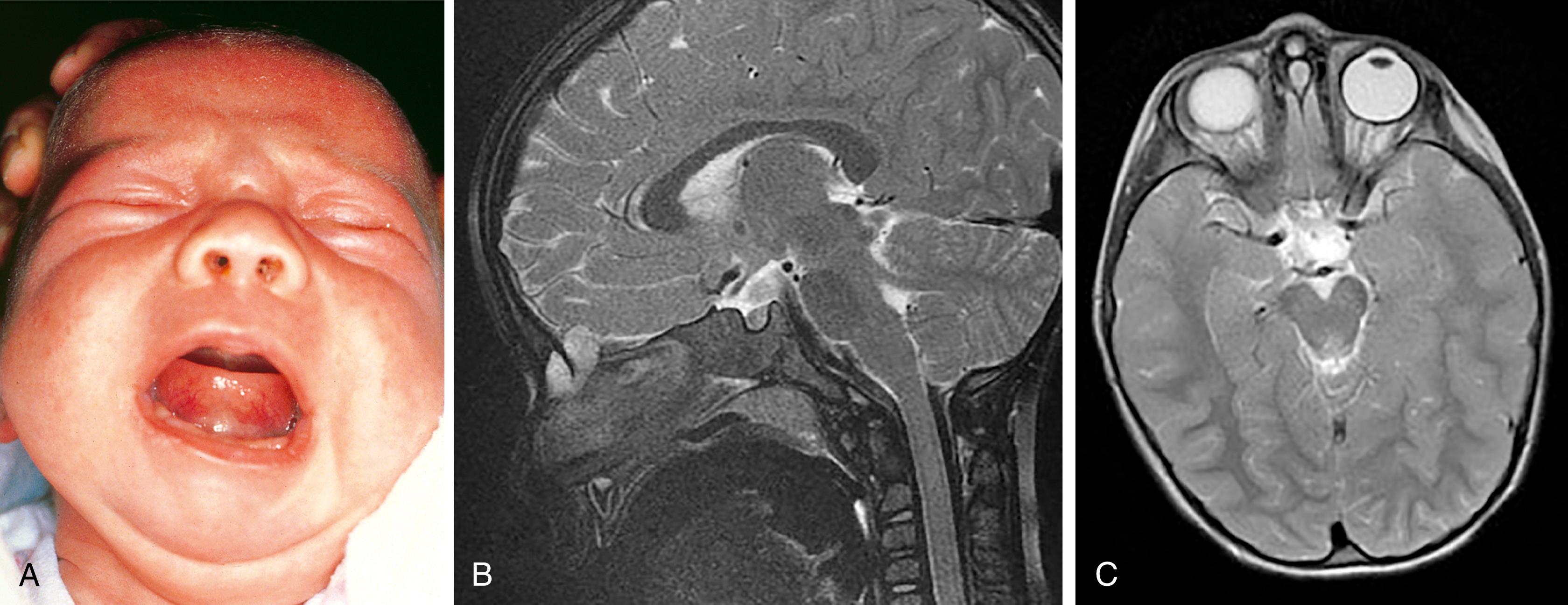
Obstruction of nasolacrimal duct occurs in ∼30% of neonates. Most obstructions are mild and self-resolve within the first year of life. When proximal and distal obstruction occurs, a cyst known as a dacryocystocele forms and may herniate into the nasal cavity inferior to the head of the inferior turbinate. Cysts are distinguished from other nasal tumors by the superior-medial displacement of the inferior turbinate. CT scans are helpful to confirm diagnosis ( Fig. 24.39 ). Frequently, dacryocystoceles rupture at or soon after birth with minor trauma (suctioning). The minority are bilateral. Common associated clinical findings include epiphora, facial or lateral nasal swelling, and a bluish to red discoloration inferior to the medial canthi. Cannulization and marsupialization is often needed if conservative measures, warm compresses, are unsuccessful.
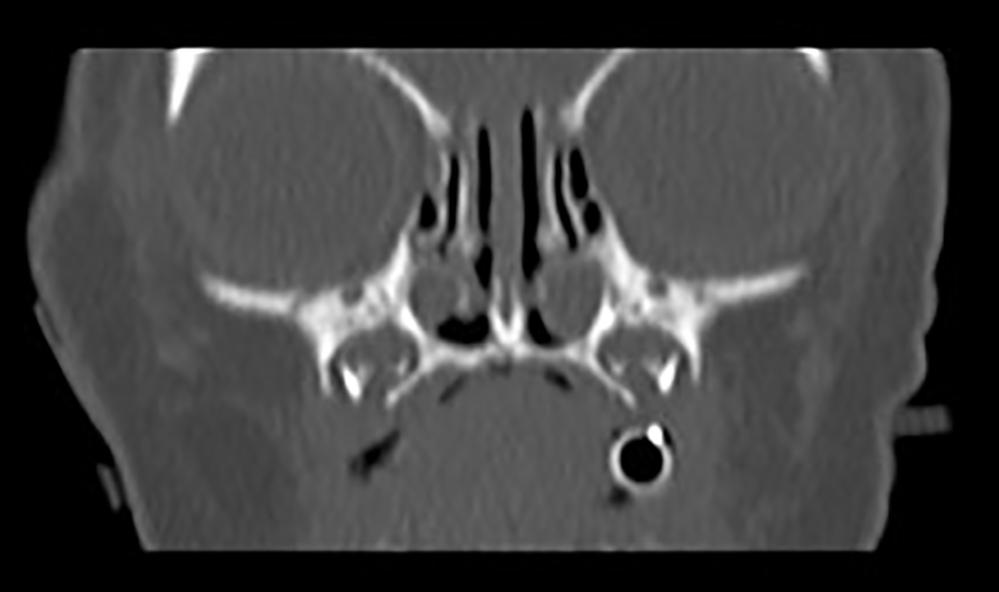
The lymphoid tissue that constitutes the tonsils and adenoids is relatively small in infancy, gradually enlarges until 8 to 10 years old, and then usually begins to shrink in size. In most instances, this normal process of hypertrophy results in mild to moderate enlargement of these structures and does not constitute a problem. A small percentage of children, however, develop marked adenoidal and tonsillar hypertrophy, with attendant symptoms of nasal obstruction and rhinorrhea. A few even have difficulty swallowing solid foods, such as meat and bread. Recurrent infection appears to be the most common inciting factor, although atopy may play a role in some cases. On occasion, EBV infection is the initiating event, resulting in rapid enlargement of adenoidal and tonsillar tissues that is then slow to resolve (see the Tonsillitis/Pharyngitis section, later and in Chapter 13 ). In most children, progressive adenoidal enlargement appears to be the cumulative result of a series of upper respiratory tract infections. The consequent obstruction to normal flow of secretions then starts a vicious circle, making the child more vulnerable to recurrent infections of the ears, sinuses, and nasopharynx, which in turn further exacerbate the adenoidal and tonsillar hypertrophy.
Regardless of the mode of origin, when adenoidal hypertrophy is marked, blockage of the nasal airway becomes severe and results in mouth breathing, chronic rhinorrhea, inability to blow the nose, and snoring during sleep ( Fig. 24.40A ). Speech becomes hyponasal and muffled. The child holds his or her mouth open and has little or no airflow through the nares, and his or her tonsils may also meet at the midline (see Fig. 24.40B ). A lateral neck x-ray examination reveals a large adenoidal shadow impinging on the nasal airway (see Fig. 24.40C ). For many patients, these features are noted primarily in the course of acute illness; however, a number of children have symptoms even when free of acute infection. When obstruction is severe, sleep disturbance may result. This is characterized by restlessness and retractions when recumbent, snoring, and frequent waking. Some patients begin to sleep sitting up, and many manifest daytime fatigue, irritability, short attention span, hyperactivity, enuresis, and headaches. Obstructive symptoms are worse during sleep because relaxation of the pharyngeal muscles further increases the degree of upper airway obstruction. In severe cases, this results in periods of hypoxia and hypercarbia. Because a patient may look relatively healthy when awake (with the exception of having to breathe through the mouth), it is important to observe for retractions and to assess the pattern of breathing after the child has been recumbent for a period of time or, better still, during a nap. Use of polysomnography may help confirm or establish the diagnosis and determine the severity of sleep apnea. If severe obstruction persists for a prolonged period of time, cor pulmonale (with signs of right ventricular hypertrophy on electrocardiogram and chest radiograph) and abnormal facial growth may result (see Fig. 24.40D ).
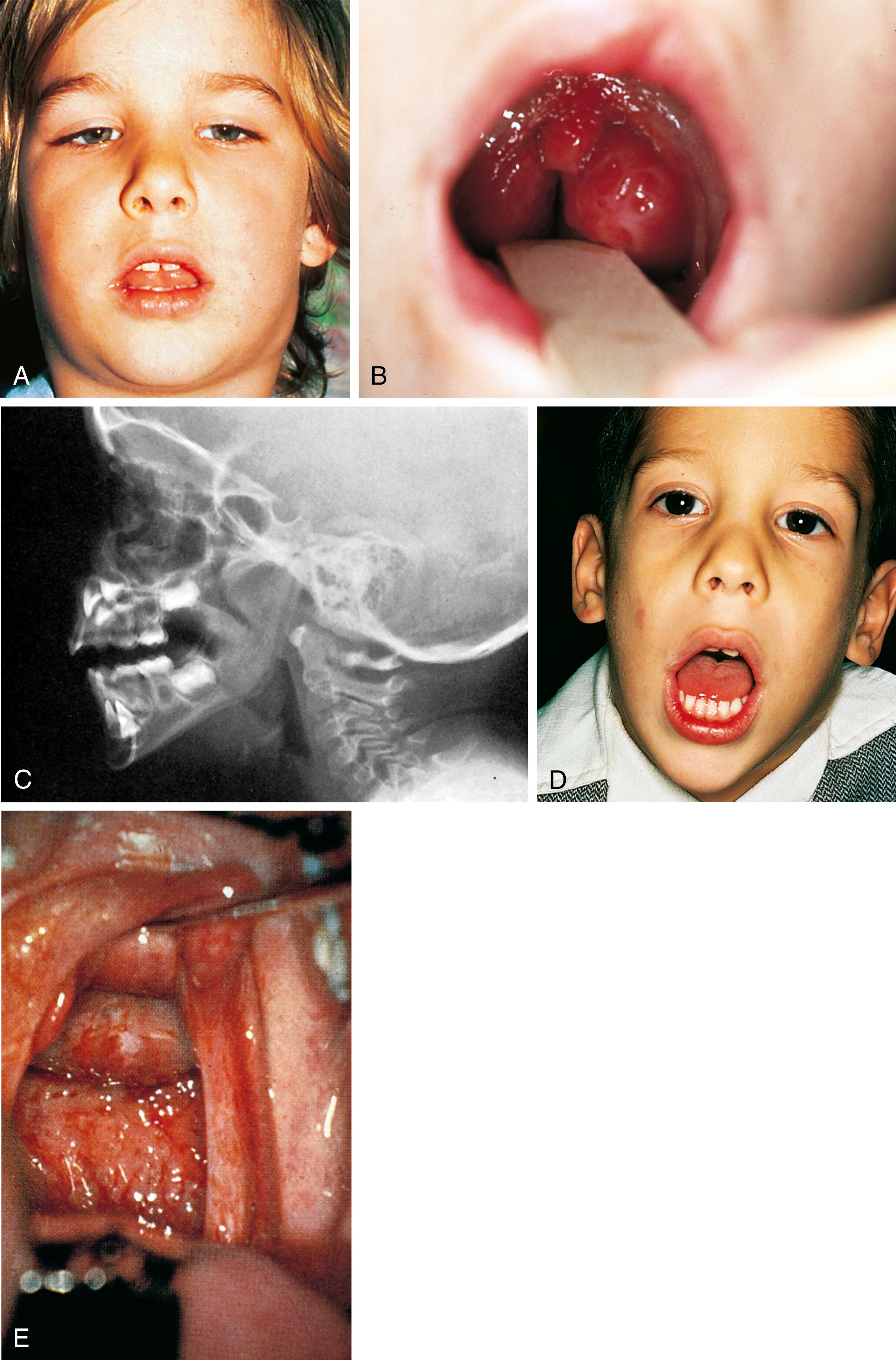
Management of patients with adenoidal hypertrophy depends in part on the severity and the duration of the obstruction. In milder cases of short duration or in patients with intermittent symptoms, careful monitoring is recommended. Treatment of atopy and inflammation with intranasal steroids, use of leukotriene inhibitors which target leukotriene receptors within the adenoid bed or institution of a 2- to 4-week course of antimicrobial therapy with a β-lactamase–stable agent may result in significant shrinkage of hypertrophied tonsillar and adenoidal tissues. Children with persistent symptoms despite therapy and those with sleep disturbance or cor pulmonale should undergo adenoidectomy, during which the extent of adenoidal overgrowth can be fully appreciated (see Fig. 24.40E ). Children with major orthodontic abnormalities and nasal obstruction also should be considered for adenoidectomy before orthodontic correction.
Rhinitis is nasal mucosal inflammation, whereas rhinorrhea refers to nasal secretions. Frequently, both are present. The etiology of rhinitis and rhinorrhea is vast and can include environmental irritants (tobacco, dust, pollution, etc.), allergies (both inhaled, contact and ingested), bacteria and viruses. Some children are more responsive to irritants and allergies than others and inflammation from one cause can predispose children to more severe reactions to secondary causes. Underlying structural anomalies such septal deviation, sinonasal anomalies, turbinate hypertrophy, and adenoid hypertrophy (see later) can result in obstruction of nasal secretion flow and contribute to worsening inflammation and bacterial infections. Environmental controls, use of nasal saline as a mild topical decongestant, mucolytic agent, and to “rinse” irritants if any, followed by topical anti-inflammatory or antihistamine medications and or systemic medical interventions, are all possible therapies.
Nasal turbinates are paired structures present in the nasal cavity consisting of a concha bone and surrounding mucus secreting mucosa. Turbinates function to warm, moisten, and filter air. The mucosal lining can become hypertrophic in response to irritants, allergens, and infections. When enlarged, nasal turbinates can result in nasal obstruction as well as increased rhinitis. Topical medical therapies such as saline, topical corticosteroids, and topical antihistamines may be helpful in reducing mucosal inflammation and reduce rhinitis. Surgical intervention to reduce turbinate size exists and can be used if medical therapies fail.
As with the external ear, it is not unusual for small children to put a wide variety of foreign material into their noses. Such foreign objects are irritating to the nasal mucosa and soon incite an intense inflammatory reaction with production of a thick, purulent, foul-smelling discharge that helps to hide their presence. Intermittent epistaxis may accompany the discharge. Because most children younger than 5 years old are unable to blow their noses and are afraid or unable to tell their parents what they have done, the object is not expelled and the problem often goes unrecognized until symptoms develop and medical attention is sought. A unilateral nasal discharge and/or a foul smell are the typical chief complaints and should lead the clinician to suspect a foreign body immediately ( Fig. 24.41A ).
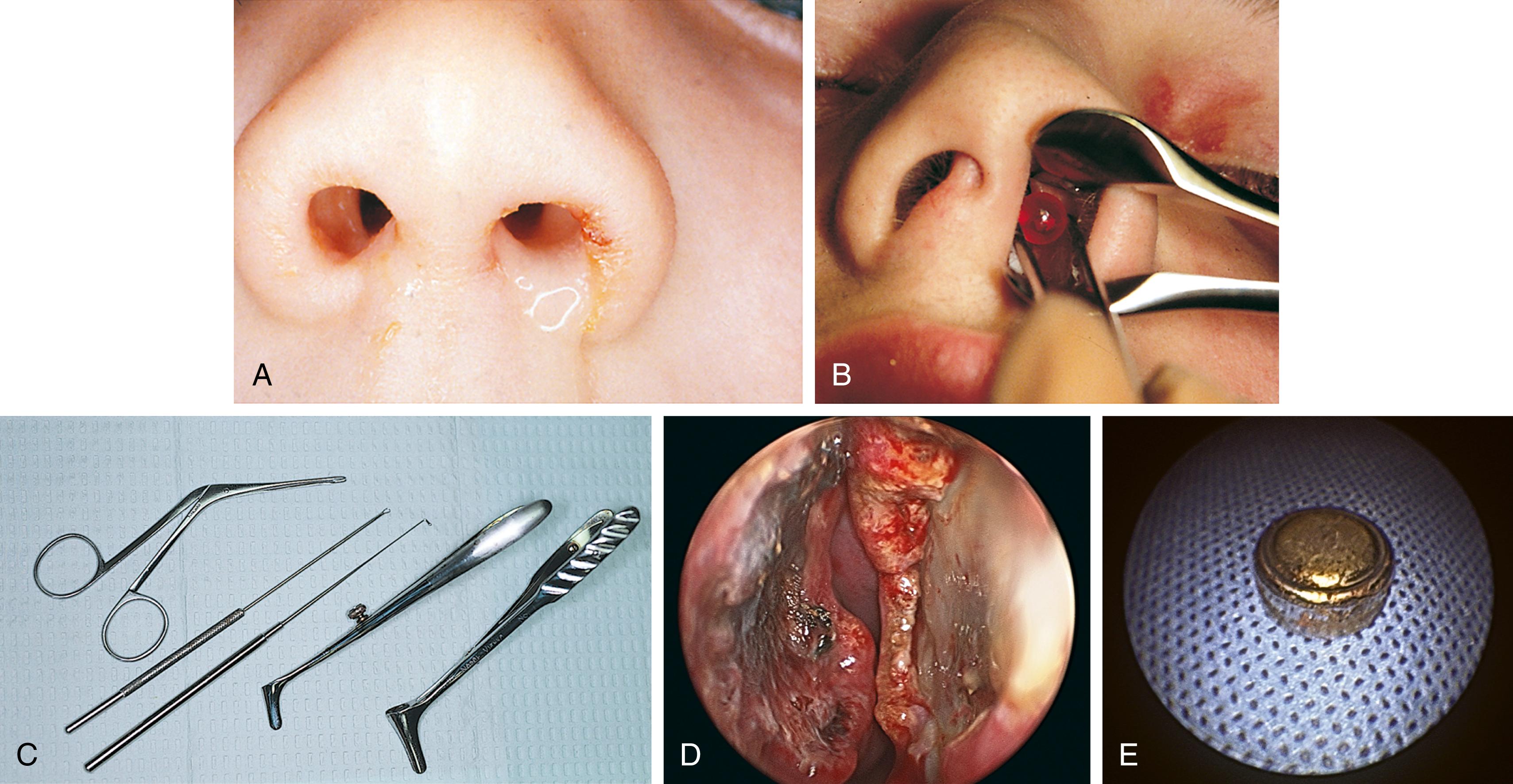
Speculum examination may readily disclose the object (see Fig. 24.41B and C ), but often the purulent discharge obscures the view, necessitating removal with an absorbent swab or via gentle suction. Even when visualization is accomplished, removal can be difficult because children are easily frightened at the prospect of instrumentation, and their struggling can result in mucosal injury during attempts at removal. To minimize problems, topical anesthetic spray and a topical vasoconstrictor can be applied, and the child can be restrained with a papoose board. Older patients or calm young children may do well sitting in a parent’s lap, if the examiner is patient, reassuring, and willing to explain each step carefully. The discharge may then be removed by swab or suction. If the object is anterior to the turbinates, removal can be attempted using suction; a small wire loop curette or a right-angled Day hook for spherical objects; or otologic forceps for material that can be grasped (see Fig. 24.41C ). Consultation with an otolaryngologist should be sought for removal of objects located more posteriorly or those not readily removed on initial attempts. A major concern is that in the attempted removal, a deeply situated foreign body may be dislodged into the nasopharynx, leading to aspiration or, worse, laryngeal obstruction. In such cases, the best course of action is to remove the object after the airway has been secured with an endotracheal tube in the operating room, with the patient under general anesthesia. Significant bleeding may occur during attempted removal of an intranasal foreign body, and this is another reason to strongly consider general anesthesia with an endotracheal tube to secure the airway. Small button batteries such as watch batteries in the nose can cause a great deal of caustic tissue injury from the electric current. Therefore, all batteries should be removed as quickly as possible (see Fig. 24.41D and E ).
Polyps are thought to be the end result of recurrent infection and/or inflammation, although atopy may play a contributing role in a portion of cases. Polyps originate in the ethmoid or, less commonly, the maxillary sinuses and protrude through the sinus ostia into the nasal cavity. The phenomenon is unusual in children younger than 10 years old, with the exception of patients with cystic fibrosis—25% of whom develop polyps, some as early as infancy. Symptoms consist of those of progressive nasal obstruction, frequently with associated discharge. Recurrent sinusitis is a common complication as a result of impaired sinus drainage. In some cases, chronic sinusitis may be the cause of polyp formation. Affected patients with acute infections may also have intermittent epistaxis. Involvement may be unilateral or bilateral. On examination, moist, glistening pedunculated growths that may have a smooth or a grape-like appearance are seen ( Fig. 24.42 ). Bilateral opacification of the ethmoid and maxillary sinuses is commonly found on radiography. Polyps must be distinguished from a nasal glioma or encephalocele, which may have a similar appearance and can produce identical symptoms. These neural mass lesions are more common in infancy but may present in older children. Therefore, before biopsy or removal, a CT scan of the sinuses and skull base should be considered for children with polypoid nasal lesions.
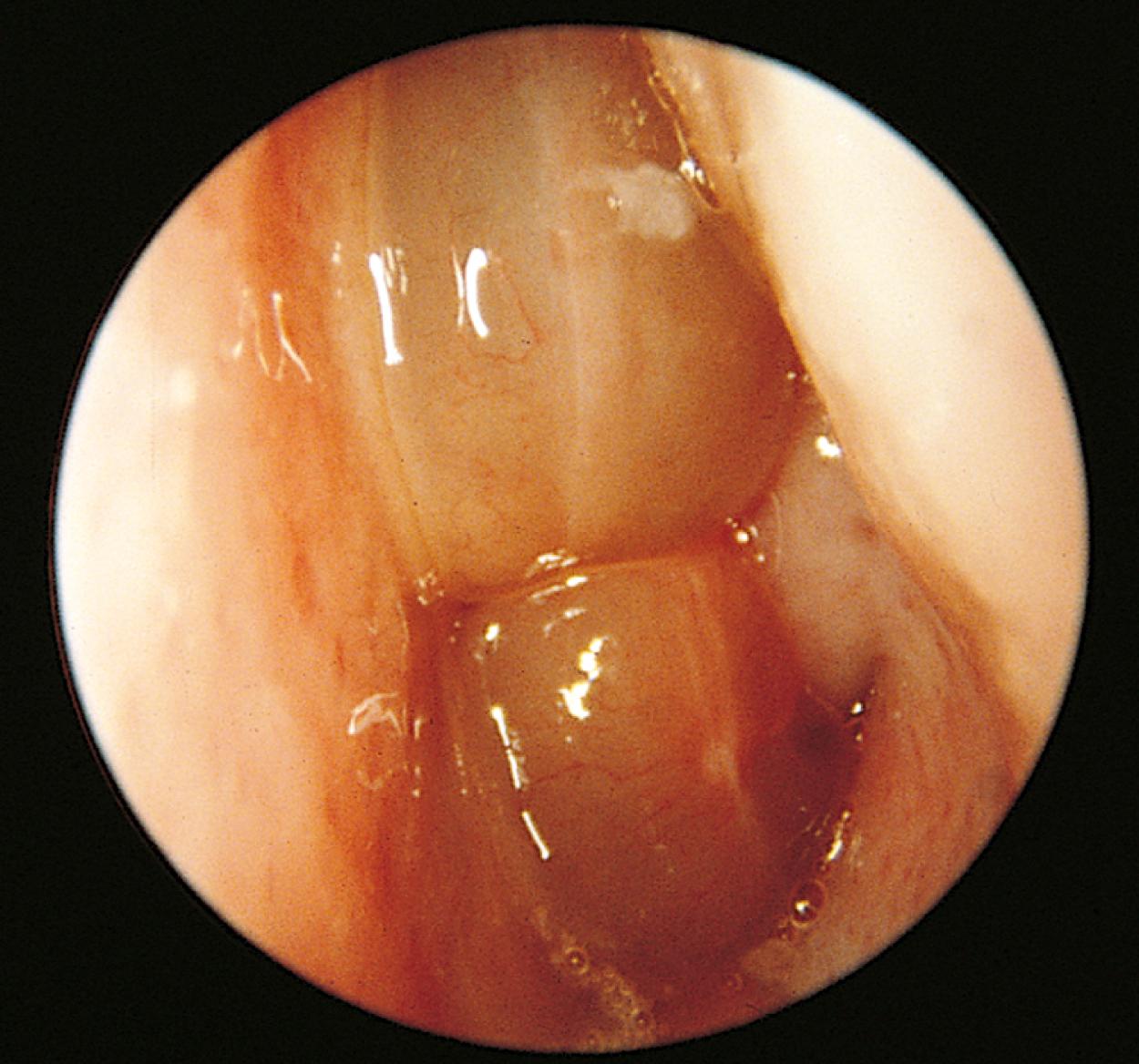
Surgical removal of the polyps is indicated to relieve nasal obstruction, reduce the risk of secondary sinusitis, and diminish the possibility of altered facial growth. Another problem seen in children with chronic polyps (most frequently those with cystic fibrosis) consists of widening of the nasal root and prominence of the malar areas of the face ( Fig. 24.43 ). A child with nasal polyps warrants evaluation for cystic fibrosis.

Become a Clinical Tree membership for Full access and enjoy Unlimited articles
If you are a member. Log in here